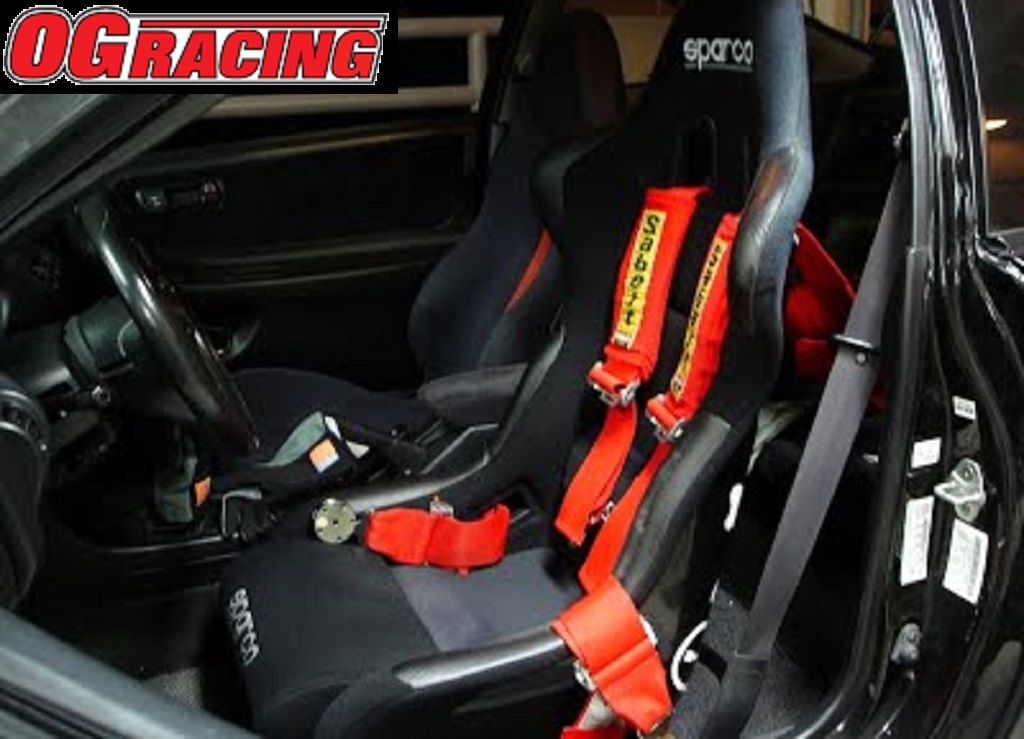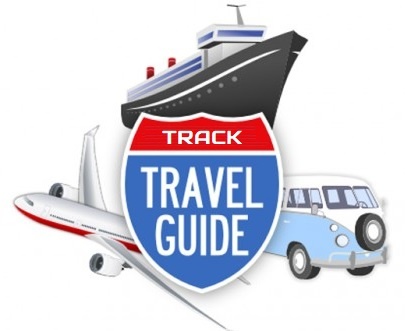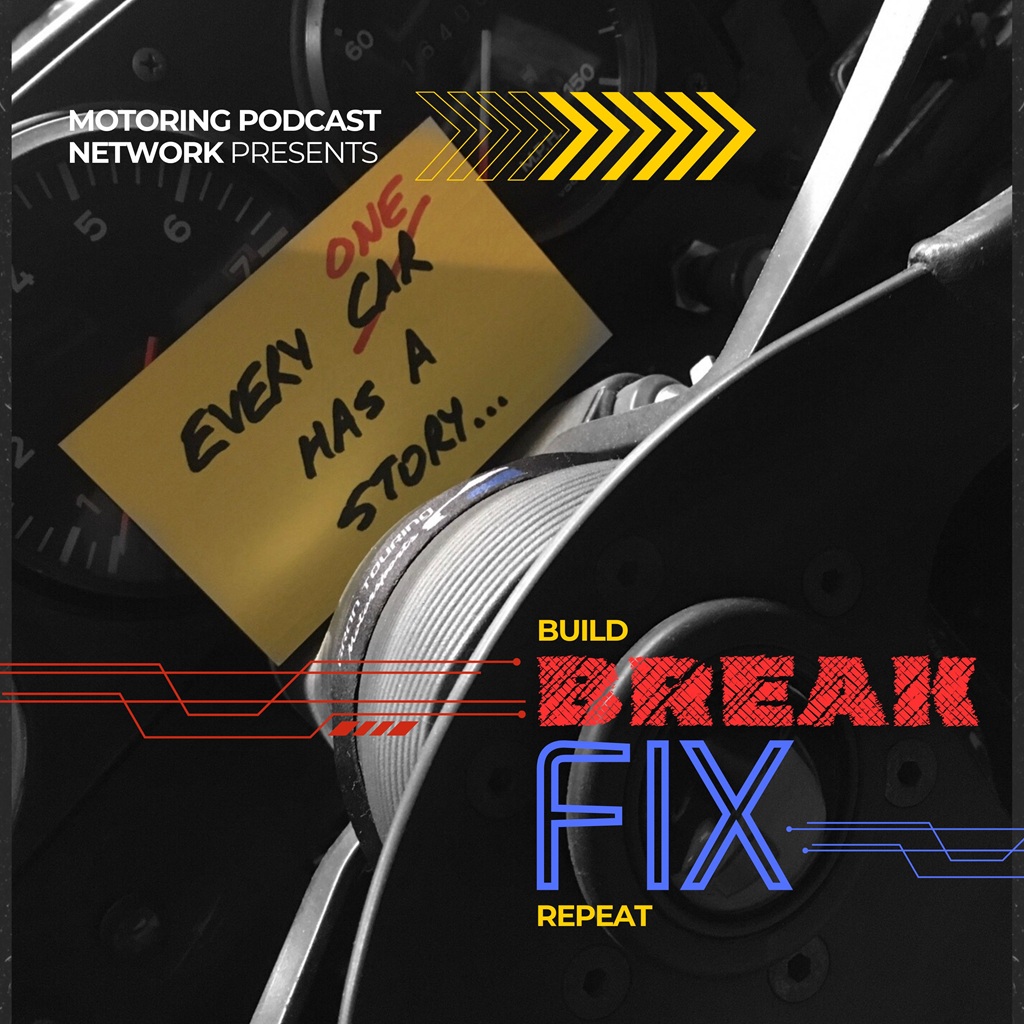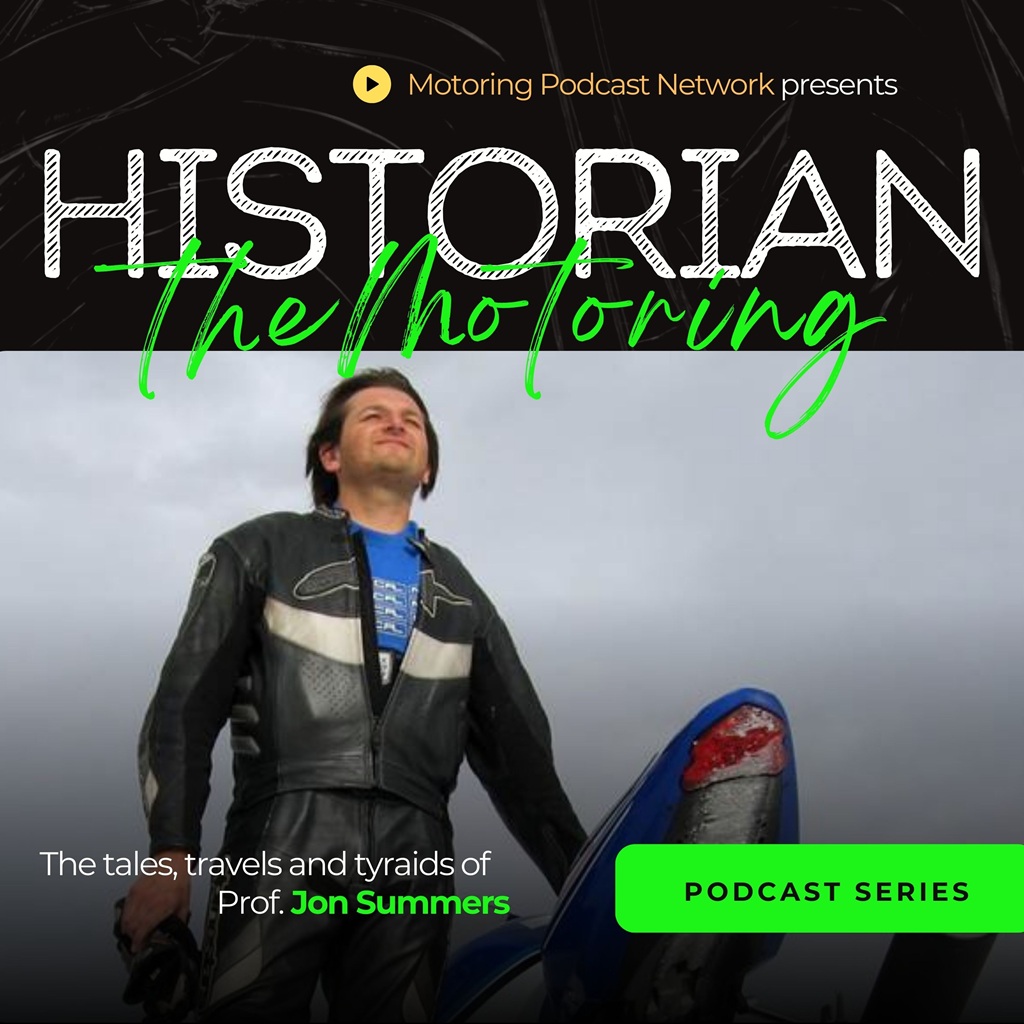If you’ve been following along with our previous episodes, you’ll note that we’ve been focusing on what it takes to get involved in Motorsports. We’ve covered everything from picking the right Starter Car, to getting ready for your first event and different programs and organizations that exist in this community.
And on tonight’s episode, we continue this talk-track as we dig in deeper… talking about the question that’s always on everyone’s mind: SAFETY. And with us we have returning guest Mike Crutchfield on behalf of the GTM coaches, along with our special guest Mark Francis from OG Racing, one of the largest Motorsports Safety distributors in the US – to discuss a concept we call “SAFETY AS A SYSTEM.” (SAAS)
Tune in everywhere you stream, download or listen!
 |  |  |
- Spotlight
- Notes
- Transcript
- Highlights
- Learn More
Spotlight
Mark Francis - OGRacing
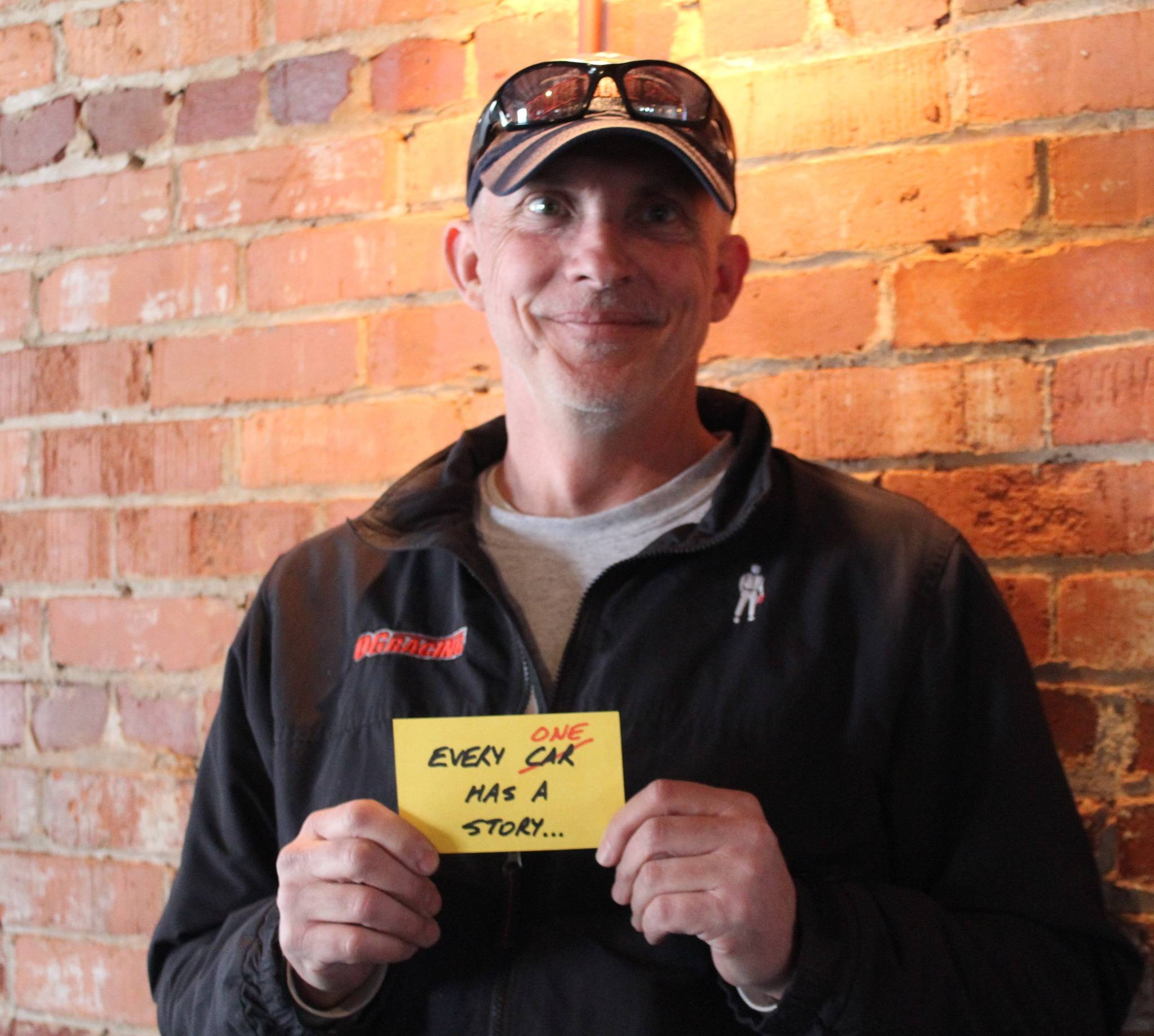
OG-Racing was founded in 1990 with the intent of "Making Racers Safer." Started from the back of the Bill Love's pick-up truck, OG-Racing has grown to become one of the largest distributors of Motorsports Gear in the country. From our full line of racing suits, to the latest helmets and neck protection, we're constantly striving to make sure the latest technology is keeping you safe. Our personalized customer service by an enthusiastic and friendly sales staff will ensure that everyone from the casual autocrosser to the Speed World Challenge racer receives only the best in customer service and support.

Contact: Mark Francis at mark@ogracing.com | 571-449-1243 | Visit Online!![]()
![]()
Notes
Steering Wheels. Wheel Sizes, Leather vs Suede
Belts, Harnesses and Seats. 4pt… 5pt vs 6pt.
Fixed vs Adjustable Seats
Proper Head and Neck restraints. Hans & Simpson Hybrid
What is “equal restraint”?
How to shop for racing gear? – Picking the appropriate helmet for you.
Looking stylish: Racing Suits, Gloves and Shoes
and much, much more!
Transcript
Crew Chief Brad: [00:00:00] Grand Touring Motorsports started as a social group of car enthusiasts, but we’ve expanded into all sorts of motorsports disciplines, and we want to share our stories with you. Years of racing, wrenching, and motorsports experience brings together a top notch collection of knowledge and information through our podcast, Brake Fix.
What’s going on, everybody? Tonight, it’s your host, Brad, and with me as always is Eric. If you’ve been following along with our previous episodes, you’ll note that we’ve been focusing on what it takes to get involved in motorsports. We’ve covered everything from picking the right starter car to getting ready for your first event and different programs and organizations that exist in this community.
And on tonight’s episode, we continue this talk track as we dig in deeper, talking about the questions that’s always on everyone’s mind. And with us tonight, we have returning guest Crutch on behalf of the GTM coaches, along with our special guest, Mark Francis from OG Racing, one of the largest motorsport safety [00:01:00] distributors in the US, to discuss a concept we call Safety as a System.
Welcome to the show, Mark.
Crew Chief Eric: Hey, Eric. Thanks for having me. I don’t think we can deny the fact that we all get excited over buying yet another mod for our cars. And lots of people buy items like seats and belts and steering wheels without really knowing what the impact to them or their vehicle might be.
So our plan tonight is to address some of the more popular safety items with Mark and explain the do’s and don’ts, as well as talking about how they’re designed to work together. So how about we get into it? So Mark, first up, let’s talk about steering wheels. Should drivers be changing them? Should they be going to a smaller size, a larger size?
Is there a debate about leather versus suede?
Mark Francis: I found that leather versus suede really for drivers picking aftermarket wheel for their car comes down to preference. I generally tell guys when they’re looking at wheels, if it’s a dual purpose car, you know, it’s a car they drive to work or at least sometime on the street.
A [00:02:00] suede wheel with the oils and things from our skin will eventually wear on them over time. Where, you know, in a race car, you got gloves on, so you don’t have that issue. On my track car, I prefer suede. I just like the feel for some reason. The two really comes down to preference. I do discourage guys sometimes think they want to go down to like a smaller wheel, which, you know, if you drive a car without power steering, that smaller wheel requires more effort to turn the car as you’re turning in and exiting the corner, especially in like air cooled 911, no power steering.
It’s better to have a 350 millimeter wheel because it gives you a little more leverage. I’ve, I’ve no guys who like bigger three 80 or so when you jerk around and call them a school bus wheel, but Sparco makes,
Crew Chief Eric: yeah, we have the, we have the opposite problem on the front wheel drives. We always go with smaller wheels, so they’ll turn in quicker.
It just makes, makes life a little easier. So I guess it comes down to the type of car, but you know, what you’ve said so far makes a heck of a lot of sense.
Crew Chief Brad: Should people swapping wheels be concerned that they’re losing their air [00:03:00] bag?
Mark Francis: That’s, that’s a good question. Yeah, I’ll take the official line that if the car is a street car registered in a state that has a safety inspection, you are not supposed to remove the airbags steering wheel.
Now they’re saying with the new cars with the smart airbags being part of the system and built into the seats, that debate has raged on the forums. I don’t own a car new enough to have that problem. You know, the cars on the track have airbags in them. I have seen car have a single car off at some point years ago.
You know, 80s car had, you know, early first generation airbags in it and he didn’t even hit anything. He hit a bump, you know, going through the gravel trap and turned three at summit in the airbag deployed, burned his wrists. It was a summer event where they were allowing short sleeve shirts and he drove into the pits and tossed it out onto the ground of the pit lane and went back on the track.
Mike Crutchfield: I have seen, there was some car. One of the recent generations, it was, it was some performance car was like a Corvette or Mustang or something that was actually, I think it was one of the Corvettes was actually having a problem with accidental [00:04:00] airbag deployment during spirited driving where people were driving around racetracks and the airbags would just happen to trigger in some situations.
And this wasn’t just the wheel airbag. I think it was one of the side curtains too. So there’s always the risk of that, but then that gets back to the whole safety as a system thing. Whereas if you’re taking out that Steering wheel airbag, you know, that’s part of your defense against the type of neck injuries that the full harness hands and helmet and all would take care of.
So Exactly are taking a risk by swapping out just that steering wheel when not going with the rest of the system as we’re going to talk about
Crew Chief Eric: I mean, I think you’re taking a risk if you have a car equipped with Takata airbags to begin with so I have removed all of mine and we’ll move on from that statement.
Mike Crutchfield: You mean claymores?
Crew Chief Eric: Yeah, yeah, exactly. So with that
Mark Francis: actually, I got the recall for my m3 I need to make the appointment of the dealer. It’s in stock now to replace mine
Crew Chief Eric: Yeah, my recall is right in the waste bin But uh with that being said so people the next thing people really get excited [00:05:00] about for their car, you know I’m going to the track.
I gotta buy seats And they don’t realize what they’re getting themselves into And it blends itself to a conversation not just about seats and proper seats, but belts You And harnesses and all sorts of other things. So let’s begin to slowly unpack that. Let’s talk about seats. There’s all sorts of different kinds of seats out there.
Be them fixed back metal fiberglass, Kirky aluminum, and then you have your adjustable seats, et cetera. Let’s talk about the good, the bad, and the ugly when it comes to these different seats, especially in the context of motorsport.
Mark Francis: I’ll share a conversation I usually have when I get a say like an HPD to, you know, PCA blue group.
I’m not sure how you guys break your run groups down, you know, the driver that’s maybe had his 1st solo, you know, he’s talking about putting our compound tires on the car. And then when we get into the discussion about seats, you know, they’ll ask [00:06:00] me, but, you know, should I get like, what about like a reclining sports seat?
And I tend to steer them if they’re going to do it. You know, if this is a car that’s primarily track, then a fixed back seat is a better option. The sport seats I’ve found don’t provide as much lateral support. And it’s, it’s amazing with these guys when they, you know, you have a guy that’s been driving with a street seat or even, even like a reclinable seat that has at least shoulder pass throughs to run like a four point belt.
And I guess we’ll discuss the belts in a little while, but when they get into the fixed back seat, that’s when they realize how much. They were holding on, you know, whether pushing their knee against the door, holding onto the steering wheel to keep themselves centered in the seat. And they’re like, you know, I should have done this two years ago because it, a proper race seat keeps you centered, relaxed.
So you’re, you’re not using your, the muscles in your body to try to stay put and keep from sliding. You know, I, I did it when I was a beginner knee pushing on the door panel to try to keep me in the seat. You know, my [00:07:00] feeling has always been if, if you’re gonna put seats in track card, especially if you have.
aspirations for moving on to time trials or club racing at some level. Skip the sports seat because you’re going to get to the wanting a fixed back seat anyways.
Crew Chief Eric: So how does one choose the right seat? I know that’s always a big thing, right? It’s like almost like buying shoes. So in your opinion, how do you, how do you choose the right seat for you or for your car for that matter?
Mark Francis: I tell people that I talked to that, you know, don’t live near an OG racing where we have a showroom. You know, seats out on display. You can walk in there and spend three hours trying on seats just like you could try on shoes. But I’ll encourage him when you’re at the track, you know, go talk to the guy who’s there has got a race car there in cage.
Say, Hey, you mind if I sit in your seat? And then I also tell him, you know, don’t walk over there eating a chili dog. and have food all over your fingers or screwdrivers in your pockets, you know, be mindful of that. A lot of guys will probably say, sure, man, have a seat. You know, if you don’t have an idea of what fits, [00:08:00] it’s hard to pick one.
They all fit a little differently. You know, we have, you have a lot of manufacturers out there, Sparco, O& P, Racetech, Recaro, some of the other ones that the tuner guys like, I think the bride seats and Momo, Seibelt, the Kirky aluminum seats, Butler seat, you know, the list goes on and on and on. But they’re all sort of shaped a little differently in the case of like the fixed back seats that are FIA certified, they’ve passed the same testing and of course, with exception being the race tech seats that have that newer certification up to 60 G’s.
I forgot the number on it, but our body types are all different. So, you know, find one of these seats, you know, uh, SPARCO and O& P Ricardo, they’re all high quality. They’ve all been designed properly, gone through the testing, the safety testing on them. I’ve seen the end results of rollovers, hits in the tire wall, multiple hits in the tire wall, hits in concrete walls with all of them, and it’s amazing that they hold up.
They do. I’ve got one in my basement. The car was, and while at [00:09:00] some point on the outside going into one, the car rolled three twice in the air and turned around and came down with the back end facing the skid pad. Landed upright and the seat held. The side mounts, as soon as we unbolted them from the seat, they sprung crooked.
But everything stayed in place, driver walked away and was in the paddock, but go for fit because a race seat is just like a pair of shoes. There’s nothing worse than walking around all day and a pair of shoes that don’t fit right. Or pants that are that don’t fit right, you know, think of the seat that way because, you know, that’s your desk, you know, think of that as the business and.
When you’re in the cockpit, that’s what’s keeping you secure, you know, along with the rest of your safety system, you know, your harnesses and everything, but, you know, that’s the office you want it to be comfortable.
Crew Chief Brad: I was just going to piggyback on what Mark was saying about walking around the paddock and talking to people and asking if you can sit in their seats.
If you’re going to do that, look for someone that’s got a similar body type to yours. Good point. I meant to say that you’ll hear it in our big [00:10:00] guy, little car episode, but there’s several people that we’re all six, four. I mean, there’s like five or six of us that are six, four, six, five in the group, but we all have different body types.
We’re all different sizes and we don’t fit in each other’s cars because of that. So look for somebody that’s of a similar build to you and then ask if you can sit in their car, assuming they have this stuff that you’re, you’re interested in buying. Okay.
Mark Francis: Yeah, it’s an excellent point.
Crew Chief Eric: A lot of people nowadays are shopping online for a lot of things.
And maybe, you know, I found that great deal on Amazon for that, you know, Corbo seat or something. I don’t know. Is there a guide though that, you know, how to measure yourself and then measure a seat for fitment? Like, as an example, um. I find the older Corbeau TRS is super comfortable. A lot of people hate them.
I also find the Sprint 5 extremely comfortable, but it’s a very narrow seat. My sister has a Sparco Corsas. I hate them. They’re way too narrow, right? They’re way too, just too thin. I’ve also found like the Evo 2 US is more comfortable than the Evo 2. You know, things like that. But I also know my [00:11:00] measurements because I’ve sat in a lot of different seats, like, you know, minimum, you know, so many inches on the bottom and, and height and all this kind of thing.
But is there a good reference or a guide out there for people that are shopping that aren’t able to go to a showroom?
Mark Francis: Yeah. All the manufacturers do put out their own sizing charts where they’ll measure, you know, width across the shoulders, torso length from bottom of the seat to the shoulder belt cutouts.
They’ll measure in the hip area. at the front end of the seat, you know, between your thighs and your and your knees. But they, they tend to measure some areas a little differently. We’ve been trying to standardize it, you know, so you could do a side by side comparison. Right now with the manufacturers, you know, doing certain measurements on, they vary, um, it’s hard to compare a Recaro For SPARCO to an OMP because of their sizing charts are different.
I’ve tried to take that data, one, put it in U. S. standard of measurement, and also try to get the measurements from the same points to do a comparison. Where I try to give [00:12:00] them a starting point is, you know, make sure it’s not too tight in the hips where it’s going to pinch. Because, you know, that’ll lead to discomfort over the course of a 30 minute session on the track.
And also the, you know, the importance of making sure your shoulders are not totally above the shoulder belt openings, where it makes the shoulder belts have to go in an incorrect angle. It would create compression when you tighten the belts. You know, we try to avoid that. I tell them to sort of use that as a starting point.
Crew Chief Eric: We’ve talked a lot about different kinds of seats. And one of the next things that comes into question is whether those seats should be fixed or on sliders. What is your recommendation when it comes to that?
Mark Francis: If you’re using a proper double locking slider available from Sparco, OMP, Recaro, and if you’re sharing a car, you know, in a lot of cases, person’s not able to fix mount it.
And, you know, my race car, I had a slider in it because my wife drove it. And if you have a, you know, height difference, you know, it can’t fit. You know, if Brad and I were to, if we’re going to share a [00:13:00] car, you know, we’re going to have to have a slider in the car. You know, being that he’s 6’4 The times where I’ve seen people not use them is Person not sharing a car and it’s somebody who’s tall because someone who’s short, you know, where their seats position when they’re driving may now, but they have trouble getting in and out of the car.
I’ve seen that too. You know, in the event they had to get out of the car in a hurry, they’re squeezing out because the seats fix mounted and you know, they’re five foot three sitting right up on the steering wheel.
Crew Chief Eric: I’ve also heard some wives tales about sliders aren’t safe because it’s a failure point in the whole system there.
Mark Francis: This is where you run into. People buying stuff on eBay. Counterfeit sliders that aren’t double locked that could fail. The lock mechanism fails. Now, if you have a race seat in the car with harnesses on and everything, the harnesses are attached to their mounting points. The seat can’t go forward and slam you into the, you know, into the dashboard.
You know, because the harnesses aren’t going to allow it. It goes down to, you know, proper installation [00:14:00] in most cases. You know, rarely have I seen a slider made by a motorsports manufacturer fail. The car I was telling you about that had the big hit at some point and the rollover, and it was airborne and came crashing down, fortunately right side up, that car had a slider in it.
The slider was, you know, we threw all the, all the hardware was replaced afterwards, you know, because it was such a violent impact, but it did not fail. Everything was still locked in place where it should be.
Mike Crutchfield: So that brings up an interesting question that often comes up, which is when you’re using a fixed back seat without a roll hoop, without any type of roll bar, you now are in a seat that has no way of deflecting out of the way in a rollover crash, and you are.
Also, held more upright in a rollover crash.
Mark Francis: My thoughts on that, when I have a person asking about seats, my next question is, Do you have a roll bar or a roll cage in the car? Are you going to be installing one when you put the seats in? And I’ll tell people if they say, [00:15:00] No, I’m going to do that later, that I tell them to don’t do the seats now.
The beginners don’t see it as a system. They see it as, Oh, I can add this piece. And then next month I’ll add that piece. If you’re going to do it right. When you get to that crossroads, when you’re driving on the track, you know, when people start talking about racing tires, Oh, I’m going to put a super truck.
I’m going to, I’m going to do a flash on my nine, nine, seven turbo. Are you putting seats in a roll bar? Oh no, I’m going to use three point belts. That’s what I’ll tell them. Don’t please don’t do that. I tell them, you know, whether it’s someone I’m instructing, who asks me or someone who’s asking me. You know, in my role at O.
G. Racing, you know, which there’s so much overlap, you know, for me, it’s just about one of the same at this point, I will tell them when you’re going to a fixed back seat, you want to start using harnesses, roll bar or roll cage, you know, obviously, if it’s a dual purpose car, you don’t want to tell the output of, you know, put a cage with NASCAR bars and everything in a car, you’re going to drive on the street, you know, that presents its own safety [00:16:00] hazards.
You know, like hitting your head on that section of the cage in the front with no helmet on , if you’re driving the car on the street,
Mike Crutchfield: it’s very refreshing to actually hear someone in the business say that because we have had experience with other vendors that have toed the benefits of, uh, fixed back seats that’ll hold you in place better.
And you know, it’s a cheap and easy upgrade and that’s the only thing you need to do to get better lap times. It’s good to hear vendor proper advice.
Mark Francis: I’m, if you have a person that’s not putting the roll bar rollover protection in. And you’re going to sell them a fixed back seat. And what are they using for?
Are they using a three point seatbelt? A racing seat with the higher bolsters on the sides. There’s another set of problems you’re creating with the lap belt, not being able to, you know, that retracting locking. Part of your street safety system, not functioning properly. If it’s not over your hips,
Crew Chief Eric: Like you said, three point with a fixed back seat with will cause submarining in an accident.
I’ve [00:17:00] heard that, you know, harnesses with a, with a regular stock seat or adjustable seat, we’ll break your pelvis in
Mark Francis: an
Crew Chief Eric: accident.
Mark Francis: And I’ve seen people do that. I’ve seen guys get in the car and take their three point. It goes right over the top of those. Tall five bolsters, you know, like on a O and P WRC or a Cobra Suzuka seat.
That’s got those big, tall five bolsters. I’m like, you’re going to slide right underneath it. You know, because the pretension thing that locks it, you know, in the event of the hard deceleration or an impact isn’t going to be able to function because the belt’s not across your hips.
Crew Chief Brad: And I think that’s the overarching theme of this entire episode is safety is a system.
Yeah, you can upgrade your seats and your harnesses and you get your head and neck restraint and everything and the roll bar, that itself is a system, but your car’s stock OEM equipment is a system in and of itself.
Mark Francis: Yes, so if you start mixing. That’s in pieces of the two. They don’t, the pieces don’t fit.
Crew Chief Eric: They become a disparate [00:18:00] system. That’s what they’re known as. I think you touched on something really important here as we lead into the conversation about belts versus harnesses, but there’s one more piece to the seat equation that I don’t think a lot of people understand, but it does lean itself to another later part of the conversation where we talk about head and neck restraint, because again, this is all a system.
The whole point of the conversation here is we are building up the To a kind of final package, what you should be really at and that, that investment that you need to make. So the other one here about seats in particular is halos and everybody looks at them and goes, Ooh, that’s super cool. That halo seats really kind of neat.
But the problem is there’s a time and a place for a halo seat, just like there’s a time and a place for a fixed back seat. So would you care to elaborate on the whys and why nots of a halo seat?
Mark Francis: Yeah. Okay. The whys. In a race car with the rest of your proper safety system, it’s a good idea. It protects, you know, from that lateral impact.
Pancake into a door, car hitting you in the [00:19:00] door. You hitting it, hitting the tire wall into the door. You know, the head neck restraints are primarily focused on that forward motion. Now, with the advent of some of the newer ones, like the, you know, the Simpson hybrid s that the way the tethers are designed, it is To help sort of offset impact to keep your head straight.
Halo seats in a race car. Good idea. Halo seats in a dual purpose car. You’re driving on the street. Not so good idea because they limit some of your side vision that you need on the street. You know, that quick look over your shoulder, changing lanes, you know, where you go to check your blind spot. Can’t do that with a halo seat in street driving.
Crew Chief Eric: And we’re not going to get into the extreme versions of these systems, but with a halo, the expectation is that there’s a window net. And that there’s arm restraints, there’s all sorts of other things that a full club racing car would have that your normal HPDE driver just getting started with, who were, you know, catering to in this particular conversation, that’s way beyond what they need to go to the track.
Mark Francis: Yes. Yeah. [00:20:00] For, for our HPDE friends and students, customers, you know, wherever you want to refer to us, it’s not something that’s highly required. You know, it’s, that’s my personal feeling on it. You know, like your car, if you made the out of your full on race car, I would say, yeah, it’s, it’s another part of the system that reduces your chances of injury.
You know, should you have an impact or, you know, an off that leads to an impact, you know, especially our guys with the dual purpose cars, we have a lot of them. I see a lot of them at the, you know, whether it’s one of your events, PCA, driver’s ed, BMW, CCA, HPDE, NASA. You know, there’s a lot of guys driving the cars to the track.
One of my coworkers does it. He’s got race seats in his car and a harness bar, which I keep telling you need a roll bar, dude. You need a roll bar because he’s getting up to the point he’s soloing now. Now he’s still on street tires, you know, so I’ll give him that. He hasn’t like slept Hoosiers on the thing yet.
Crew Chief Eric: But what I want to talk about Mark next is really the difference between a belt and a harness. So do you want to explain 3. 4 0. 5 0. 6 [00:21:00] point? I mean, soon they’re going to be up to 10 points, right? So what does all that mean to somebody that’s just starting out?
Mark Francis: Well, of course I tell people, you know, we all use the term.
Oh, what kind of belts do you have in the car? Even though what we are referring to are their racing harness. Obviously, belts to the beginner, three point seatbelts. I know that there are some four point ones out there now. It used to be that going on the track, a lot of car clubs would not let you use a four point with a race seat on the racetrack.
Because it did not have, you know, an anti sub belt. Which is that belt that comes up between your legs to keep you from sliding out from under the belts. Now, I know that Schroth makes one that has that, where it, it tensions the shoulders. I, I forgot how they work. I, I haven’t tried them.
Mike Crutchfield: I’m pretty sure the way the Schroth four point works, in order to prevent you from submarining, there’s a doubled over section of belt on one shoulder that breaks free in an accident so that it lets your body roll forward to not go under the belt.[00:22:00]
So it simulates a three
Mark Francis: point.
Mike Crutchfield: Yeah, simulates a three point tensioner with a four point belt. Oh,
Mark Francis: so it breaks, so it breaks away probably on the inside one so your body can go.
Mike Crutchfield: Yeah.
Mark Francis: You know, not towards the window.
Mike Crutchfield: Yeah, it doesn’t break away fully. It has like a section that’s folded over and stitched, but not stitched as strongly.
So that it then becomes longer on just that side.
Mark Francis: So the stitching were full if you were to have a hard impact. Because I’ve seen people get those and use them with a stock seat. I’ve just never been a fan of that. And I know in the old days, even in Porsche Club, you could use a harness with a stock seat and have the sub, like a sub belt, just go right up in front of you.
Which, of course, now has been pretty much banned by everybody. Seat has to have a proper pass through.
Crew Chief Eric: But I think the consensus here is four points are a no go, don’t even bother, you know, I mean for the cost differential, buy a five point or a six point, whatever you can get. One of the things that I wanted to call into question was CG [00:23:00] locks.
What do you think of those for the folks still running three point belts?
Mark Francis: Um, I tried one one time, we don’t sell them at OG, I don’t think OG ever did, you know, it was nice that it did tighten the, you could get the left, you know, the portion of, you know, as you came over your, to snap into the receptacle, you could snug it.
So it was firm on your, across your hips. I didn’t see it as a bad thing, but I just, I, like I said, I never, you know, never really used one in practice. I know the people that bought them like them. I don’t think they create any safety hazards. But as you know, as I tend to tell people, you know, if you’re looking at that kind of stuff, start considering doing the safety system, you know, as your next upgrade.
But back to harnesses, yes, you know, now there are these 4. 1s that they say they are legal to use with race, seat, and tested, you know, the FIA has tested them. I don’t know about SFI, since they’re a European manufacturer. And I don’t think I’ve ever sold a four point belt to somebody [00:24:00] and then there’s five and six point now rate six point Basically, you have a sub belt that’s doing the same thing as your sub belt the five point harness But it’s got two attachment points, which you know has more places to make sure it doesn’t come loose or come out You know the better
Crew Chief Eric: it’s always a debate between what’s better five and six and different companies don’t even make fives anymore I mean, I I buy g force and they go either way depending on how you want to say They make
Mark Francis: Yeah, the SFI belts, they make either way.
The European belts that I’ve been seeing, you know, the last five, ten years, are all six point. Racetech at one point made a five point, but they haven’t for a long time. So I think the FIA standard now is six, you know, for competition. And it’s, and it’s basically two attachment points. You know, for the sub instead of a single,
Crew Chief Eric: but yes, some people want to save a buck or two, like you said earlier, you know, go on the eBay router on Amazon.
And so there are some manufacturers that are more expensive than others. I’ve priced out different ones. I have a tendency [00:25:00] to like G force belts because they’re wider. So some people don’t take that into consideration, the width of the belt across their shoulders and across their hips and things like that.
They tend to be a little bit wider. Sparcos are a bit narrow and this is just a personal thing. I dislike Shroff because of the placement of the cam. I don’t like it on the sub. I prefer it coming across my hip. So there’s all these other considerations when you’re looking at belts and the way your car is set up, maybe the way your cage is set up, you know, my cars are set up for time trials.
So I’ve got a different. Type of cage in my car. So all these things are taken into consideration during the setup process So I think that’s it’s very subjective when it comes down to that But I think we can all agree that five and six point are the way to go Especially if you’re going to use a fixed back seat So the bigger question that is unanswered is the why should you never run harnesses with a stock seat?
Mark Francis: Because the shoulder belt, you know race seats have a pass through for a reason So they come straight over your shoulders and down You You know to where they attach to the laps and the [00:26:00] sub through the cam lock in the case of those And they still make latch link ones too with them around this going around the seat There’s where there’s a chance for it to slip off your shoulder, despite how tight you get them, because they are not coming straight, they have, you’ve now created a curve.
They have to go around that, you know, the back of the seat, and then come back over your shoulders. It’s not a good way to go. Most of the track groups, and I’m guessing you guys are probably the same, Have it in the technical regulations. You cannot use a racing harness unless you have a racing seat.
Crew Chief Eric: Yes That’s true,
Mark Francis: right?
Crew Chief Eric: Yeah,
Mark Francis: everyone’s gotten away from that The other thing I wanted to say why we’re talking about belts on is for your listeners to be very careful of what you buy Online, I don’t know if you guys have seen the now semi infamous video of the guy Somewhere in Eastern Europe who bought counterfeit OMP harnesses for 40 euros.
And they said these were OMP [00:27:00] FIA six point belts, the guys in car video. It’s all over YouTube. And I think it’s been on Facebook and he had an impact into a tire wall. Those belts failed in multiple places, including the tabs. That you would, uh, you know, the, the snapping ends that would go into an eyeball, right?
Those broke. Yeah. These were counterfeit belts. The guy’s chest hit the steering wheel. The steering wheel was deformed. I mean, he went forward to the inside, came back and is sitting there, slumped over moving and obviously a lot of pain. So if you see a, what should be a 350 pair of harnesses for 50 bucks and they say they’re brand new.
Okay,
Crew Chief Brad: so you mentioned that the slots in the seats and the sport seats are designed to allow the belts to pass through straight over your shoulder. Now, because of my size, There are very few seats where those inserts or those holes are straight over my shoulder. Is that something that I need to be concerned of as a [00:28:00] larger person?
Or is it the belt coming into the seat a little bit lower, going up over my shoulder? Is that still okay?
Mark Francis: In the car you drive now, are your shoulders, you know, an inch above the top of the opening? Or are they somewhat, somewhat close?
Crew Chief Brad: I would say probably about an inch,
Mark Francis: Over the from the top. What seat do you have in the car?
Crew Chief Brad: Well, i’ve got a corvo sport. I don’t have harnesses. I’ve got i’m still using a three point I’ve got a corvo recliner, but this is something that i plan on doing over the off season So I want to make sure that I get you know, the correct seats for for my body type, you know, not just fitment wise but with the the inlets for the for the harnesses as well
Mark Francis: Are you tall in the torso, legs, or a little of both?
Crew Chief Brad: It’s a little of both, but primarily in the legs.
Mark Francis: Being long legged and tall is actually, it makes it a little easier. Most of the manufacturers now make a wide and tall or tall for, you know, people your height. [00:29:00] It’s 6’4 so there are certain seats you’re not going to fit in. But there are seats out there that, and this would, this would be another thing to sit in.
You know, a couple examples, Sparco makes this new one called the Pilot. It’s a halo seat. You know, if I sit in it, my head is probably three inches below or four inches below the top of the seat. You know, I’m only 5’11 You know, the shoulder belt opening the bottom of the shoulder belt cutouts is probably three inches above my shoulders But I sat in one just for giggles in this showroom race tech make in some of their seats They make a wide then they make a wide and tall for someone You know someone your size that you would fit in it and be like wow, this is comfortable You know like it’s made for you
Crew Chief Eric: Now you have to be really careful because some of those seats get so big that you’ll only be able to track and escalate.
So if you want to, if you want to jam that in a new Mustang, it ain’t going to happen, right? With a low roof line or a Supra or anything like that. So you got to be really careful.
Mark Francis: Sparco used to make the seat. They just stopped it after 2019 was called [00:30:00] the Ergo. And they made three sizes, small, medium, and large.
The large was for tall. It was wide. In a car that still had door panels and all its interior and sound deadening. It wasn’t going to fit You know, we had a guy try to put one in a 997 and it just wasn’t going to go to the stock mounting locations If you’ve got a car where you’re you’re gutting it It’s getting a roll cage in in those cases.
You’d be surprised how big a seat you can put You know, I I saw one of those larger goes put in a cayman Now, they had cut the original mounting out, they’d made a plate, welded a plate to the floor, basically had the thing down on the floor because the guy was 6’5 but that was the only way they could get the seat in.
You know, with our friends who have dual purpose cars, yes, when you get into those larger seats, OMP used to make one called the Big. I did see a guy get into the Mustang, he tried to put two, wasn’t gonna happen. They would touch in the middle and you couldn’t close the doors. Ha ha
Crew Chief Eric: ha! I mean, this is the point where you just say, all right, the heck with it.
I’m [00:31:00] cutting the windshield and the roof. I’m going eat prepared and it doesn’t matter at that point. You got all the room in the world, but that’s a whole nother story.
Crew Chief Brad: But so, so when I, when it comes time for me to start buying my stuff, just to give OG a little plug here, I am going to go down and see the experts at OG and sit in a bunch of seats and they’re going to tell me the right stuff for my car.
So. I don’t need to worry about it because I know OG’s got me covered.
Crew Chief Eric: I mean, he drives a flying brick. I mean, the golf’s got all the headroom in the world. So
Mark Francis: yeah, I was going to say, you could, you would, if you strip out a golf, there’s a lot of real estate in there to put a big seat in. And of course with the big tall roofline,
Crew Chief Eric: he’s got nothing on mic though at the beetle talk about headroom He’s swimming in that thing But at any rate so we we’ve talked a lot about seats But let’s kind of wrap up this conversation about belts and seats together because there’s something really important here from a coaching perspective because a lot of organizations will lean on us as instructors to say You should really do [00:32:00] a kind of ocular pat down of these belts, you know.
Check them out, do an inspection. And I’m like, what the heck does that mean? Am I sitting here checking dates? I understand that this stuff apparently expires, but I don’t think it’s like a carton of milk where all of a sudden it’s, it’s gone bad. So can you really explain to us what it means when a belt expires or a seat expires?
When I’m supposed to kind of do this inspection of these belts or these seats, what am I looking for?
Mark Francis: What you mainly want to look for is condition. You know, I’ll give you an example. I have a pair of, a pair of belts in the, they’re in the garage. I used them once in a borrowed car. I didn’t like the belts that were in it.
I bought belts, installed them, attempted to run the club race. You know, we had some mechanical issues that led to my retirement. Took my belts out, put his belts back in because I just didn’t. I didn’t like it. I didn’t like the adjusters. I just didn’t like him. You know, it was a total preference thing.
Now, would those belts be unsafe if you took them in a car? You know, they expired in December of 2019. Would they be [00:33:00] unsafe if I took them out on the track? Of course not. They haven’t been used. Where I’ve seen old belts, belts that were expired five plus years ago, the car spent a lot of time outside. The material does degrade.
It gets stiff. The adjusters start to bind, little things like that. The clubs required, Alan, I think probably has a lot to do with liability. Uh, when the expiration date’s on the belt, they’re, they’re junk. You have to replace them and that, the sanctioning bodies go with that, the expiration date. And I know that SFI now has an expiration date on them.
The labels used to have the date of manufacturer, and you’d go two years out from the date of manufacturer, now they have an expiration date on them. They’ll say not valid past, you know, February 2021. And I just threw that in, it was a random date. But seats too, a lot of it is condition. You know, if it’s, if it’s a.
car that’s stored in the garage. Car gets taken out once or twice a year. Doesn’t HPD. It’s never had an [00:34:00] impact. You know, I told people if you’ve had a severe crash where they required the car to be towed in and you had to go to medical to be checked out, replace the seat. It has been deflected stress within the g loading that they’re tested for.
Just put another seat in the car.
Crew Chief Eric: So the last part of this triumvirate or trifecta here is the head and neck restraint. So we’ve talked about the seats. We’ve talked about the belts and you threw out there and kind of hinted at, you know, Hans and Simpson hybrids. And we talked about halos. I mean, there’s even, you know, collars and things like that.
How does that play into this whole system?
Mark Francis: One, not a fan of neck collars. You know, the old foam ones, like they give you at the cart track. In a car, at the speeds that you’re going, I don’t like it. I feel like, oh, it makes your helmet not feel as heavy, but I feel like in the event you do have a, you know, let’s say you have an impact with a tire wall, you’re going to get this sort of whiplash effect because it’s going to compress and it’s going to push back as your head goes back.[00:35:00]
I don’t know, some people may say that’s a wives tale, but I’ve just never been a fan of those. Of course, now a lot of the clubs, if you’re using a harness, they’ve made a head and neck restraint mandatory. PCA does, it’s required. I imagine BMW has done it. Not sure about NASA, but at this point, really, most people are wearing them.
You know, guys who have race seats and harnesses on the car, even if they’re HPD people are wearing a head and neck restraint at this point. I don’t see a reason not to. The knock was, Oh, I can’t turn my head. Oh, I don’t like it. Oh, it’s uncomfortable. There are multiple devices out there. You can find one that works for you, whether it’s a, you know, a next gen, a Hans or Simpson.
Simpson hybrid, the Schroft Flex, Sparco sells one that’s made by Stan 21, it’s like a Hans. They fit a little differently. You know, find the one that’s comfortable, what I tell people. You know, they’ve been, you know, the Hans and the Stan 21, you know, the Schroft Flex, you know, the ones that are European or have FIA certification in addition to SFI.[00:36:00]
Sometimes you can get one that’s either SFI, FIA, or both. I think it’s the same device and, you know, they put both labels on it. Because I know a lot of people running in the oval track world, they require SFI stuff.
Crew Chief Eric: And what’s funny about the Hans is there’s an expiration there too, but it’s a giant piece of carbon fiber.
Isn’t that the padding and the tethers that need to be updated, but not the physical unit itself?
Mark Francis: Hans wants to see your device, I think, about every four years. Go examine it. You should replace your tethers. Clubs now will check dates on tethers. I think BMW CCA. I think they think it’s like it’s it’s within two years.
They’ll make you replace them. It’s I mean, they’re cheap. They’re 40. Despite you can buy a new tether, send you Hans wants you to send the device back. They will put a new SFI sticker on it with more current dates. And I know some clubs will enforce that some do not. If you’re in an impact, I would have the device checked.
If you’re in a serious [00:37:00] wreck, send it back to them, pay them, you know, they’ll put new tethers on it, they’ll, you know, they’ll check to see if there are any cracks or anything that could render it unsafe and have it fail should it be tested again. You know, with another impact.
Crew Chief Eric: Yeah. And I mean, I spent the extra money for the adjustable Hans, which I have adjusted once and never messed with ever again.
So, you know, to your point about fitment, right. It, and I had to get the adjustable Hans because of the particularities of my car and stuff like that. And there was an issue with the regular one with clearance, with the seat and all that, again, reiterating the fact that all of this stuff works together.
You can’t just go pick it off the shelf. It all has to be fitted. It has to be fitted with you in the car.
Mike Crutchfield: So we’re talking about all this as a system and we’ve talked about them a couple of times, but is there really such a thing as a safe dual use car? If you’re using belts with other hands, you’re not safe, but if you’re using three point, if you have fixed seats in the car, you need to use belts.
To [00:38:00] get proper safety. So therefore you’d have to use a Hans while driving on the street, which means wearing a helmet, which screws with your visibility.
Crew Chief Eric: And technically it’s illegal in a lot of States to run harnesses on the street. So you still have to have a three point belt if you have tags on the car.
So it becomes a whole kind of cluster there at the
Mark Francis: day. I do know guys that will change out their seat. You know, their car has the wool bar in it. That wool bar is in the car. And they, a couple days before they leave for the track, they’ll go out in the garage and take the stock seat out, put their race seat in, you know, all their mounting for their harnesses is there.
install that, they will drive it out to the track. Some guys still trailer, even if it’s a dual use car, they’ll still trailer to a track event, you know, in the event something breaks so they can get home. If they want, they want to take the car out on the street, they’ll swap the seats out. Some states will say you can’t use your harnesses on the street.
I still think you could have a safe dual use car. I think you can.
Crew Chief Eric: I mean, Mike, I think I would want to redefine what [00:39:00] dual use means because to me, I would see it as In the case of this particular conversation, we could have a dual use car that can do autocross and track, and it would be safe for both, but not street and track and not street and autocross or hill climb or whatever.
And I will say, if you look at the different regs, especially if you go to SCCA or NASA or some of the organizations and read through like the GCR, I mean, it’s, it’s, it’s an endless Bible of information there. There’s a lot about how cages are built, how the restraint systems are supposed to be put together.
And then they will have caveats. Based on the discipline. So if you’re in rally cross, there’s extra things you have to do. If you’re in club racing, there’s things you have other things you have to do. I would say the great compromise though, if you’re looking to build a Swiss army knife from a safety perspective, and Mark, you can correct me if I’m wrong.
If you follow hill climb slash time trial spec. It’s kind of the best of all worlds, but you’re not looking at a full cage, looking at a half back, you know, you’re looking at full [00:40:00] harnesses with fixed seats, partial fire system, you know? So the car is still usable in other instances like autocross and at DE and things like that, but it’s not legal at club racing, but it’s also not legal on the street.
So it kind of sits in the middle.
Mark Francis: Well, then you look at some of the new cars that have those optional sports seats, you know, Porsche with the Corvette. The, I think the GT three 50 have those for cars in them, where they have provisions for you to use a racing harness on the track, the Porsche one. At least, you know, on the driver’s side, there’s a cutout for a sub belt.
There’s a sub bar to attach it to underneath. It’s part of the mounting system for it.
Mike Crutchfield: But now you’re back in that hole. You’re using an adjustable back seat again, still. So if you’re saying, you know, ultimate safety is a fixed back seat. There’s no way to have a safe street and track car with a fixed back seat.
Unless you’re swapping out seats like you described, you’re, you know, people you know are doing
Mark Francis: well in the ca In the case of those, I know with the Porsches, I’m not sure about, I know [00:41:00] BMW has that M 4G TS car. It’s like a, a joke and say it’s a BM BMW cup car or club sport like that came at the sport buckets.
As Porsche calls them, they don’t recline. You could tilt it slightly forward to put things in the back seat, but the seat will not recline. It’s in a fixed position when it’s upright.
Crew Chief Eric: Interesting.
Mark Francis: It’ll tilt forward just a couple inches. If you were to want to put a double bag, your gym bag into the back on, you know, where the rear seat would be like in a GT three to go to the gym.
But yeah, the, the seats do not recline. They only have a forward where it moves forward a little bit to put packages in the, in the back where the rear seats would be the Porsche world. Those are popular guys, people buying those secondhand.
Crew Chief Eric: So let’s jump back to close out the whole idea of head and neck restraint there for a second.
And you mentioned that there’s multiple vendors in that particular space, but you know, most of us know two of them and you mentioned them at Hans and it’s Simpson. So let’s, let’s throw it out there. [00:42:00] Hans versus Simpson. What do you think is Hans passe now everybody’s moving to the Simpson or is the Simpson, is it everything that it’s cracked up to be?
What do you think as a professional?
Mark Francis: I still wear Hans. I have for 15 years. I’m used to it. It’s comfortable in the right seat. I was into the tire wall and turned 10. It wasn’t a major hit. It had been a race weekend. The guy would have kept driving, but still had it, you know, we did have an impact. It worked.
And there was a lot of science. I mean, years and years of development. It was the first one. A lot of the other ones came on the scene. That was really the impetus was Dale Earnhardt’s crash. Then he saw that Hutchins, that crazy strap or contraption that some of the NASCAR guys were wearing that would basically crush your nuts and a wreck.
But it was, cause it went up between your legs and it was like, you’re wearing this like web gear thing. Never sold them, never saw anybody. You know, in our world of road courses wearing them, the Simpson hybrid s Simpson did for somebody [00:43:00] paid to have that sled tested like a Hans device and they tested it with a three point seatbelt.
It is the only device that was actually tested and S. F. I. Certified. For use with a three point seatbelt. If all you’re doing is instructing, or even if you’re driving on the track and you have no interest in putting a a roll bar, a race seat, going to harnesses, and there are a few instructors I’ve seen that do it that haven’t, you can use that device with a three point seatbelt.
I actually did a test ride with one. I had to jump in the right seat the last minute to go with the student, and his instructor had him shown, and the chief instructor said, here, you want to wear this? I’m like, sure. Might as well test drive it. Hans is owned by Simpson. Simpson also bought safety solutions, what got them that whole design for the hybrid.
It was an evolution of the old, original safety solutions R3. Came out, I think, 607, somewhere there. It’s been a long time. The, uh, the Simpson Hybrid S, not the Sport. They have another one called the Sport. It’s cheaper. It’s about half [00:44:00] the price. It has not been tested. For, uh, three point seat belts. It really, it comes down to fit.
I, uh, and it, maybe it’s be just because I’m used to it that I, I feel naked without my hands when I get in the, when I get in the car. Like if I have to get in with a green, green student with three point seat belts and I can’t wear ’em, and it, it feels funny. But I also know that, you know, I have things there to protect me in that car because it’s got curtain airbags, it’s got airbag in the seat, you know, these newer cars have airbag, you know, they come out of everywhere to keep my, my head’s not going to snap forward, or I could have a, you know, the basal skull fracture.
A lot of the other designs of, you know, the Stan 21, you know, Hans did allow some of the other manufacturers to make them under license when they were in Europe. OMP made a Hans device, said OMP on it, but it also said Hans on it. But they were allowed to produce it to Hans standards for a licensing thing, because I don’t think Hans could sell in Europe.
So there were a couple manufacturers who made them [00:45:00] under license. It really comes down to what you’re doing. If you’re primarily instructing and you’re getting, you spend a lot of time getting in beginner’s cars, the Hybrid S makes sense, because you know that you can use it with a three point belt, or if your car is equipped with harnesses, it works with that too.
Me personally, I still wear my Hans. There was a ton of science behind it. The one time I tested it, it worked. I didn’t have any neck soreness or anything the next day. I was going
Crew Chief Brad: to ask about the Simpson Hybrid S being as effective with these, you know, the harnesses as it is with the three point, because as an instructor, I actually over the winter just bought a Simpson Hybrid S because I am going to be in and out of students cars with three points.
Some students do have harnesses because they’ve got full on race cars and things like that. I wanted the Simpson Hybrid S because of the flexibility, but it is just as effective. With harnesses as it is, is
Mark Francis: it careful with the wording? Cause I don’t think that the wording that they use, they didn’t say just as effective.
They said [00:46:00] it will reduce the chance of an injury. And I guess this is the legal use that you gotta be careful. You know, the, from the lawyer speak, be careful of how they word it because they’ve said that, you know, what they’d said is they. When it was tested, it worked. We’ll be just at, like, 100 percent as effective with harnesses, I’m not sure.
Because it’s funny, and you ask them, I think you’ll get a sort of a, well, it passed the test, it passed the test, and it was certified. Answer.
Crew Chief Eric: I was gonna say, that’s like 27 percent of all statistics are made up. But, uh, continue your thought.
Mark Francis: No, but Brad’s right. Will it protect him if he’s in the right seat of that beginner’s car?
Yes.
Crew Chief Eric: Now, the thing I have with the Simpson is it looks wholly uncomfortable. Like, it reminds me a lot of the old spine protection that the kart racers had and stuff like that. So for me, I’m okay with the Hans being that yoke around my neck, but on the same token, I’ve seen it and it, there’s a sizing issue with the, with the Simpson.
To me, it [00:47:00] always seems too small on everybody I’ve seen wear it. It’s like, You know, it looks like a g string. I mean the hans kind of is like a one size fits all as long as you can Get it around your neck. It looks appropriate. It looks like it should fit at most everybody How do you size a simpson hybrid to me?
Just again. It doesn’t look right. If you’re me
Crew Chief Brad: you just buy the largest one
Mark Francis: The measurement for the you know, the strap that comes around It’s almost like if you were buying a dinner jacket the medium is like 40 to 42, which I think, you know, I wear a 42 and the jacket and my suit. I just remember, not that I’ve worn one in a long time.
And then they have the large for, it’s, it’s outfits around the torso area. And of course that little part that comes down part way down, you know, past your shoulders. It’s really the strap that seems to be bigger. I think the one I borrowed was a medium. You know, but I’m like average Joe size.
Crew Chief Eric: So what you’re saying, Mark, is I got to go to my local Joseph A.
Banks to get fitted for my Simpson hybrid.
Mark Francis: Yeah. You wouldn’t want to know your jacket, [00:48:00] like a size of like on a blazer. Yes.
Crew Chief Eric: Yeah.
Mark Francis: It would, it would, would be helpful.
Crew Chief Eric: That’s fair. I mean, I I’m like you, I’ve had a Hans for a long time. I’m probably due for some tethers. So I’ll come visit you soon. It’s really a,
Mark Francis: how, how does it feel?
Is it comfortable? Cause you don’t want the distraction of it. Like you’re sitting there and that portion of your brain is saying I don’t like this thing. It’s uncomfortable. It hurts You know my I don’t like how my head feels. I don’t like how it sits on my shoulders It really comes down to fit. I remember when the Precursor to the next gen when it was called the defender when that came out it had that You know piece that went over the belt sort of went in the piece that sat over your shoulders And they had that piece over it and I talked to a guy who bought one and he said, you know, it’s neat I like it.
I like how I I know the belts aren’t going to slip off but I have a short neck. It’s pushing the chin bar of my helmet up when I’m in the car. When he said he had a Spec Racer Ford, and when he’d sit in it, the seating position of the thing, because he had a short neck, it [00:49:00] was pushing on the chin bar of his Bell Dominator or whatever he wore at the time that had the little, you know, lip spoiler on the, on the chin.
And that, you know, that was an interesting observation and I, you know, when people would ask about them later, I’d ask them, do you have a, do you have a really short neck, you know, a lot of muscles on your shoulders and make it look like you have a short neck because you may not want to try this device.
You may want to get, you know, go with the Hans because of that extra piece that went over the belt. So it really comes down to fitment there, you know, all the devices out there these days have all been tested. You know, with the crash test dummies and shown to work. And then of course, you know, Brad’s case, he liked the hybrid S because he does a lot of instructing.
And a lot of times it’s in a car that doesn’t have harnesses. So it makes sense for him. And he’s, I guess, is it comfortable for you?
Crew Chief Brad: Yeah, it’s comfortable. I haven’t had a chance to actually use it on track yet. This weekend, it’s going to be my first time, but I’ve put it on and worn it around the house.
Just for fun. And it was quite comfortable.
Crew Chief Eric: I didn’t know you, I [00:50:00] didn’t know you mowed the lawn with your helmet on Brad. That’s pretty cool.
Crew Chief Brad: Safety as a system, Eric. No, he was doing private modeling. He was only wearing that.
Crew Chief Eric: Just, just the, just
Crew Chief Brad: the Simpson in my helmet with a beer in my hand and the steering wheel of the lawnmower and the other.
I
Crew Chief Eric: mean, it does look like a combination jockstrap cod piece sometimes at the right angle, but that, that aside, So let’s switch to Mike for a second from the coach’s perspective. And there’s this concept in the classroom and at tech and even pre registration that is this, this idea of equal restraint. So let’s talk about it from your perspective, Mike, and what that means by definition.
And then let’s go to Mark to kind of back that up as to what equal restraint really means at the end of the day. So Mike, go ahead.
Mike Crutchfield: So some of it will come down to instructor preference because. Some instructors are more tolerant of risk than others, but basically it means anything that the driver has available to protect [00:51:00] themselves in terms of the seat, the restraints, and any other devices needs to be equivalent on the passenger side.
So if the driver is using a five point harness and a fixed back seat, you can’t have a stock seat and a three point belt in the passenger seat. I’ve seen cases where both sides had a Fixed backseat or even a reclining sport seat where the driver had like a schroth four point or maybe even a five point, but there wasn’t equivalent on the passenger side and oftentimes I’ve seen, especially in the case where it’s like sport reclining seats and where the instructor just made the student uses three point belt instead.
Because when that student is using that three point belt rather than the harnesses, they actually become a little self conscious themselves and dial it back a bit. So that’s the best compromise I’ve seen in a case where there was the ability to have equal restraint, but the maximum level was not available on both sides.
Crew Chief Eric: So as we turn this over to Mark, [00:52:00] Mark, does that mean when I come into OG and I’m shopping for seats, I’ve got to buy two Oh, and PWRCs, or does that really mean I just have to have what’s known as like and kind seats are both black and they can both support five point harnesses or six point. And I have to have six point harnesses on both sides, or what’s your recommendation there?
If you’re going to do it, troughs all around or whatever, everything matching. So what is, is it a loose interpretation of equal restraint? What does it mean to you as a distributor?
Mark Francis: What it means to me is. If the driver has a race seat, there needs to be one for the passenger. If the driver is using a harness, there needs to be one for the passenger.
I see it all the I see it plenty of times and it’s acceptable. I’ve gotten in cars this way. Where the driver may have an O. M. P. H. T. E. Halo seat. But on the passenger side, he’s got a W. R. C. On his side, he’ll have an O. M. P. Harness on the passenger side. Since it doesn’t get used much, he’s got a G [00:53:00] force harness.
Am I okay with that? Yes. Does it meet the rules? Yes. Because I’m in a fixed back racing seat with a harness that I can use my head and neck restraint as the driver is doing. Yeah, they don’t have to be like a perfect match. Like, if you were to go to the track, I wouldn’t do it. I’ve never seen anybody else do it.
Oh, you have a Sparco Pro ADV. On your side, and only an Evo on the other side, no, I’m not getting in the car. Like, you don’t have to have two halos. Having a halo over the passenger seat does restrict vision, but that second one over there really bottles up when you’re, you know, if you’re trying to throw that quick glance, you know, to the right, just to double check your mirror.
You know, the way I’ve always interpreted it, and I think I’ve seen it with the clubs. I’ve seen cars go in the grid. That way, people with the passenger side, they’re going to maybe seldom going to be used. You know, if it’s an instructor that I’ll throw a passenger seat in this weekend because I may want to take my student for a ride.
Yeah, the seats don’t have to be the exact same seat and the [00:54:00] exact same belts. As long as you’re providing the same type of restraint that you have as a driver to the passenger, that’s acceptable.
Mike Crutchfield: So use Tanya as an example again. She’s tiny. She can have a tiny little seat. But she’s not going to find an instructor who fits in that tiny little seat most of the time.
So, or, or even a student, you know, if she’s instructing. So having a more general purpose friendly equivalent size, equivalent seat, like a more accommodating fixed back seat in the passenger seat that will fit a wider range of people is actually a very good idea because you’re more likely to be able to have someone safely.
seat than sitting awkwardly on top of it or, uh, uncomfortably contorted in it.
Mark Francis: That’s acceptable. I’ve seen it. I see that all the time. You know, you’ve got a driver who’s a smaller guy. He’s got his, you know, skinny European guy, Sparco circuit seat better be wearing your skinny jeans and a 30 inch waist to fit in it because it’s tight, but for the passenger side to [00:55:00] accommodate his range of instructors.
Maybe he’s got you’ve got an evo2 because it fits. I’ve seen people do that all the time Don’t they want the brand to be the same? But it’s not the same model and that I mean that’s a prep You know have some people I don’t want to have a omp driver’s seat in a sparco passenger seat or vice versa They like to at least match the brand, but yeah, you can, you want to put a seat in that’ll accommodate a wider range of passengers because your instructors are all different too.
Crew Chief Eric: Well, maybe it’s the stance bro in me. I’m vain. I want my seats to look the same. So I got matching seats for my car, matching belts. But to your point, Mike, about, about Tanya’s car, not to call her out on the episode, but you know, she’s on here enough. People have gotten used to hearing her, but yeah, she’s got matching courses in that beetle.
And I tell you Interesting story. We bought them at OG and the one she has on her driver’s side was a floor model. So it had been sat in a bunch and somewhat, I would say stretched because the one that came out of the warehouse is really tight and it’s really [00:56:00] uncomfortable. I don’t know what it is, you know, yeah.
The padding,
Mark Francis: the padding compresses. You know, even the parts you can’t take out, you can pull the bottom cushion and the, and the five bolster cushion. And even the, on the, the old days before they made it a one piece, you could pull that little pad that’s behind your back. They call that stuff out.
Interesting that one, the, the one she ended up putting on the driver’s side was the display. And after being sat in by however many people over the course of a year or two. Padding got a little compressed.
Crew Chief Eric: It is so much more comfortable. I’ve sat in the passenger one and it’s like my whole bottom half goes numb after a while.
I mean, it’s a really tight seat. Yeah,
Mark Francis: the Corsa, Corsa is a tight seat. I’ve sat in those.
Crew Chief Eric: But she’s, you know, she’s of, of, uh, a smaller stature. So for her, it’s perfect. But for the rest of us, normal humans, it ain’t going to fit. But with that being said, when talking about being stylish, let’s talk about racing gear, because that’s the next thing everybody wants.
To look like a race car driver, right? So I got to get my helmet, my shoes, I got to get my [00:57:00] driving suit and all that kind of stuff. So let’s talk about, you know, helmet sizing and fitment and racing suits and cool suits alternatives.
Crew Chief Brad: I want to piggyback on the helmet discussion. Cause Mark, you and I had a discussion a couple of weeks ago about this, but I’m looking at everything through the big guy lens.
And so everything I ask is geared towards me. And Mike and the other people in the group, but the discussion of helmets and are there helmets that are lower profile than others?
Mark Francis: To answer your question, there are manufacturers who make a more compact shell. You know, like I’ve, I’ve found that, you know, out there in the market of the, of the ones that we carry and the ones that I put my hands on and put my, put my, you know, put on my head.
The Arise and the Steelos have a more compact shell than say a belt. You know, the bells tend to be a little bit bigger. And in your case, being a six foot four big guy, you probably have a lot of issues getting fitted where you don’t want your helmet button up against your roll cage and you can find some room in some of the, you know, the, of the manufacturers that do make a more compact.[00:58:00]
It still meets both the S. A. and the F. I. A. standards, you know, for, you know, the helmets that are, that are also get the F. I. A. certification, but in a tighter package. And that must be with some of the stuff they use on the inside for the padding that allows them to have the same amount of protection in a smaller shell.
You know, I always tell people when we start with helmets, You know, because all our heads are shaped differently, you know, whether it’s, you know, around the crown of our head, or some people have like fuller cheeks than other people, you know, some people have a like sort of a long skinny head, some people have a round head, and of course, a helmet manufacturer can’t make three different shapes of each model of helmet, it’s just not cost effective, so they try to get one that’s sort of in the ballpark that’ll, that’ll try to fit a wide range of drivers, and then, but then will offer different thickness cheek pads, you know, on Stilo, you can remove the crown pad on top of your head and go thicker or thinner to get the helmet to sit properly on your head.
Some manufacturers don’t let you take the cheek pads out. I think they all should at [00:59:00] this point, but not all of them do. You know, they’re glued in and the one piece piece from the whole bottom half of the helmet. But that being said about our heads are different. When you go to try helmets on, Try for fit.
So it’s just like a pair of shoes. You’re not going to buy a pair of shoes that are uncomfortable. You don’t want a helmet that’s uncomfortable. It’s not only as a protecting your noggin, but you don’t want the distraction of, man, my head’s, you know, my helmet just doesn’t fit right. And one common mistake, a lot of first time buyers make with a helmet, they buy a helmet that’s too big and they slip it on.
So you’ll think, Oh, this feels pretty good. And then after you, you wear it and break it in and the padding compresses a little bit and you find out later. You know, I’ve seen people in a panic. I look at them like, your helmet’s too big. Maybe they just went on a website, you know, googled, you know, whichever model helmet it was and hit the first link that popped up, purchased it online, didn’t talk to anybody.
You know, there, there are, you know, measurement you can take to get you in the ballpark. If you have the opportunity to, if you’re at a track that has a track side store, [01:00:00] like Summit Point has the Mach 5 Pro Shop. They have helmets in there. You can go try on a couple different brands. If you go to NJMP, the general store, she’s got different brands of helmets in there.
Try one, try one on if you can. Because there’s nothing worse than having an ill fitting helmet.
Crew Chief Brad: A lot of beginners will come out there with a motorcycle helmet that they borrowed from their buddy. And can you explain why that’s a bad idea?
Mark Francis: Well, it’s funny. I’ve seen, including PCA, will let you use a M rated helmet through Blue Group, which would be like, you know, the equivalent to HPDE 2 and NASA, or, and I’m sure like your intermediate group, I guess, with, with Hooked on Driving.
It’s not the beginner, but they, it’s still, you’re in an instructed group, but the drivers in there have experience. You know, once you get to solo groups, they require an SA or FIA rated helmet. I could see the beginner coming out for the first time. You know, he wants to check it out and see if the hobbies for him, you know, [01:01:00] if the guy’s been coming out to the track for two years and he’s still wearing a motorcycle helmet, he needs to get a helmet because they’re, I think they’re crash tested differently.
And of course, motorcycle helmets won’t have a fire resistant lining to them. Like, you know, like a helmet made for motor sports comes down to having the proper gear. The beginners, I get it. You know, if you’ve been doing it, if you go through a first season of it, obviously you’re committed at that point, it’s time for the proper helmet.
Crew Chief Eric: So I think you make a really valid point there. And I’m sure the listeners are probably scratching their heads going. When you talk about crash resistance, technically a motorcycle helmet would have better crash resistance than a car helmet would just because of the fact that you’re in the open air.
But I think what the major difference here is, is the fire retardant part of the helmet is much more involved. In a car because you’re in an enclosed space, unless you’re running that he prepared Miata, like we were talking about earlier, but so that’s the real big thing here. And that’s the reason why, you know, when we [01:02:00] talk about a lot of this stuff, again, it works as a system.
There’s a lot of Nomex gear that we wear in motorsport that you don’t wear on a motorcycle motorcycle. You wear leathers. I mean, granted there’s. Probably some fire retardant stuff on motorcycles too, but it’s very different. The, the, the race suits are different. Everything is different between those two disciplines.
So in this case, car helmets for cars, motorcycle helmets for, for motorcycles, that is the rule of thumb, but I’m glad to see that some clubs to get people ingratiated into the sport are allowing them to at least not sacrifice their investment and say, Hey, for your first couple of events, come on out with your M helmet.
And you’re good to go. I’ve also seen that we’re carting, we’re carting for whatever reason requires SA helmets and not M helmets as well. Again, look at the different disciplines to see what the regulations allow. And go ahead, Mike.
Mike Crutchfield: The cart, you’re strapped into the cart
Crew Chief Eric: that has
Mike Crutchfield: gasoline behind you.
Usually motorcycle, you just fall off. Yeah,
Mark Francis: skip it, skip [01:03:00] it, skip it, skip across the ground like skipping a stone.
Crew Chief Eric: Let’s go back to fitment for a minute. Cause we, I don’t think we closed that, that thought and to your point about bigger helmets and things like that. And this is why it’s important to get fitted.
There are companies that run small in terms of their cut. So it’s like, you know, It’s funny. A lot of this is like buying shoes. Once you know how you fit a certain manufacturer, you know what to buy. And you’re always that, you know, let’s say size 11 Adidas, even though you’re actually a nine and a half, because a nine and a half is super uncomfortable just because they cut them small.
So the same is true. I found of like Sparco and some of the other helmets, I prefer the bells. I want to try on a Rue. But I don’t want to look like an astronaut with all those hookups either. And we’ll talk about that in a minute,
Mark Francis: but I have
Crew Chief Eric: found my actual fitment size. is an L and I have a large bell and it’s, it becomes incredibly uncomfortable even after I’ve broken it in.
So [01:04:00] what I’ve done is I upgraded and I wear an XL and it’s ridiculous, but at the end of the day, after a long day, I, I feel less claustrophobic and I don’t have all that, that pushing and, and basically the headache that comes with wearing a helmet that realistically fits me, but really doesn’t fit me comfortably.
And so I think it’s really important that people do try them on and try on all sorts of different helmets because a large sparco is not the same as a large bell is not the same as a large room at the end of the day.
Mark Francis: No, you know, like, exactly. I’ve worn, I’m on my fourth bell helmet. They’re all size seven and a half and they’re four different models.
As they progressed over the years. They’re consistent. They consistently fit me. If I put on, were to put on an Arai GP6, I need an extra large. I can’t even get a large on my head. Stilo large plus. I don’t remember what size Simpson I tried on, but Simpson just didn’t fit my head. It was, nothing wrong with [01:05:00] the Simpson helmet.
It’s my head, the shape of my noggin just didn’t fit in the thing. Same with the Rooks helmet. Wanted one of those with the integrated communications gear. I was like, I was all about it. I tried changing cheek pads. What it was, was around the crown of my head. My head just didn’t fit in it properly. Just not comfortably, or it was like it was sitting more on my head than my head being in it.
Which is, you know, I like my, I feel like it’s in it. You know, it’s in, it’s down, it’s tight. You know, cause it’s, you know, you don’t want an uncomfortable helmet. You’re distracted because that little portion of your brain is going to be going, man, I hate this helmet, man. I hate this helmet while you’re going down the chute at some point.
Crew Chief Brad: And just to add on to that, how should a helmet fit? Like, what is the proper fitting helmet feel like?
Mark Francis: It needs to be snug. It needs to feel like it’s tight, slight pressure on your cheeks, but not that where you can’t speak without fighting the inside of your cheek. You know, that’s generally what I tell people [01:06:00] where you don’t want or the uncomfortable pressure right on your forehead.
You’ll know if it’s too tight. If you’re, you know, if you put it on in the, in the showroom and walking around and within two or three minutes, it starts to hurt because, you know, it could be that you have an inventory. I’ll go to the adventures of Mark Francis for a second. I’ve had like this in between size head.
I tried the size down and it was slightly too tight. And so the size I wear now. But the headsock is perfect. Without the headsock, it feels, after it broke in, it feels a little loose. You know, my old helmet that I raced in for several years, that I now use when I go karting, you know, I don’t, I don’t even take the balaclava anymore.
But it’s funny. It doesn’t fit the same without it. You don’t want it to feel like it without the chin strap. If you were to abruptly like flop your head forward, have the thing come off your head needs to stay in it.
Crew Chief Eric: Since we’re still talking about helmets, a lot of organizations allow you to run open face.
How do you feel about open face helmets?
Mark Francis: [01:07:00] Personally, I’ve worn one one time at a track day’s event where I was asked to get in a car and I didn’t have my gear. And I’ll tell you what, it felt weird. Because I’ve always worn a full face helmet, I’ve always wanted that protection. You know, whether it’s debris.
You know, what happens if I hit a deer? And the thing comes, you know, the pieces of it come through the windshield or the side door. You know, I don’t want to have my face messed up. Now, of course, there have been all these, you know, various discussions about open face or full face in a car with airbags. I don’t know the right answer for that one.
Because you hear on the forums, you hear everybody arguing both sides of that all day long. I mean, personally, I like the idea, I like a full face helmet. Open faced for autocross on the track. I don’t know. It just it just feels weird It’s just like why you know, I wouldn’t go out on the track without a shirt on or barefoot
Crew Chief Eric: So visors up or visors down when you’re behind a windshield.
Mark Francis: I keep mine cracked at the bottom. I need a little airflow I just get I [01:08:00] get claustrophobic when it’s shot all the way but then again I’ve never driven an open car. Obviously an open car would be closed So i’d have to i’d have to learn how to deal with it
Crew Chief Eric: You know, there’s other parts to this whole setup The helmet is just part of it And nowadays the helmets are already pre drilled for hans weiss’s and simpsons and all that for anchor posts and whatnot But yeah, they have
Mark Francis: the threaded they have the threaded terminals are molded into the shell during the manufacturing process Yeah, you’re not allowed to drill any holes in a helmet right now.
It’ll void the certification You I know FIA has made that very clear, you know, the days of, you know, wiring up radios and popping a couple rivets in to rivet the connection for your earbuds onto the side of the helmet. You know, we used to drill helmets for Hans anchors. I’ve guys used to drill holes in the, in the chin bar to want to drink to, you know, you cannot do any of that anymore.
It voids the certification.
Crew Chief Eric: That’s actually really good to know because I had a helmet drilled years ago. And so I didn’t realize that that was the case. Well,
Mark Francis: back then, well, back then you could back the, you know, the [01:09:00] pro team that you see the, the pros running the 24 hours of Daytona with a drink tube going right through the chin bar.
Now you can’t make any alterations to the shell for the, for the FIA. Um, that’s why you see these manufacturers now like Stilo and Rooks, it’s already in there and there’s like a little cool shirt adapter on the side to plug a drink line into, you know, to get your hydration. You know, the threaded terminals are now in there to screw the Hans anchors into.
No more getting painter’s tape and a sharpie and a tape measure and measuring and drilling holes in it and putting a backing washer between the padding and the shell and screwing the anchors in. That went out with the SA 15 helmets. All the SA 15 helmets had Threaded terminals molded into the shell during the manufacturing process, trying to get in line with the FIA certifications.
Crew Chief Eric: So since you brought that up, we actually talked about this a good bit on an episode called things I wish I knew as a new, where we discuss helmets and gloves and things of that nature with, with Brad and Mike, who are here with us tonight. [01:10:00] And one of the things I wanted to talk about. Just bring up again, since we’re talking about it, is the expiration and certification dates of helmets now.
Mm-Hmm. , most people don’t realize helmets are good for about 11 years, and that’s because there’s a one year grace period there where the new helmets generally aren’t out yet. And so, you know, you aren’t gonna buy your 2020 helmet until probably 2021. And that just has to do with manufacturing, logistics and, and all that kind of stuff.
Yeah.
Mark Francis: Time. Time for the time for all the distributors. To have inventory for you to make a selection. Yes, exactly. I was made aware that two weeks ago, SCCA has said they will allow an essay 2010 helmet through next year to the end of the season. So I think other clubs will follow suit at least maybe to six months.
I know in the past, PCA and NASA have said, you know, we’ll let you use it till, you know, June 30th of the, of the next year. By then, we’ll want you to have it. In 2015, there was a, there was a [01:11:00] supply shortage when the SA 15s came out. Bell had moved their worldwide manufacturing. There was obviously logistical hiccups with getting that up and running and getting the helmets produced.
Two other manufacturers didn’t even release theirs till January of 2017. was by the time we received them. So we’d already missed a year, you know, going through the, uh, the, uh, essay ratings, you know, testing process. They were late, but yeah, generally you’re right. A lot of the clubs will, we’re going to give you that grace period.
In this case, SCCA has said the end of 21, right? The other clubs have not made a decision yet. They’ve implied that, yeah, we’re probably going to give you some extra time, but they haven’t, they haven’t put it you know, in an email blast yet. Uh, what it is. At least I haven’t seen it.
Crew Chief Eric: And correct me if I’m wrong, most of the reason the helmet quote unquote expires, I’ve heard two different things.
One, the outer casing or, you know, the M& M shell there, holding all that gooey chocolate inside, gets brittle over time. And that’s, and that [01:12:00] wears down because, you know, and the enamel and all that stuff that’s on the outside for the paint. But also your sweat, because it bleeds into the foam and the material inside the helmet, it accelerates the breakdown.
Of the fire retardant material and all that kind of stuff.
Mark Francis: Yeah. They said that they say it could, and, you know, with each certification, they may come, they may come up with a new safety feature. That’s part of that. You know, like when FIA came out, you know, the east side of the FIA 8859. And then when they came out with FIA 8860, there was more reinforcement in the chin bar and the frontal area around the eye port.
And I think that was a, something that came out of after the. Incident where Felipe Massa took a spring off Rubens Barrichello’s brawn that hit went hit him right where his shield was, you know, that that led to them putting that piece or one of the top and now these double pain visors that you see on some helmets, you know, more protection because it because it broke through and hit him, you know, it cracked his [01:13:00] skull above his eye and it nearly killed him, but that led to, you know, changes in that reinforcement area around there around the front of the helmet.
You know, here’s a question you’re going to hear from your. Probably new people showing up at your event this weekend. You know, when are the 2020 helmets coming out? Should I just wait and get a 2020? You know, the answer is, you know, I always tell people, it depends. How much are you going to the track? Oh, I go, I do like 12 events a year.
And I asked him, are you good? Do you really, you really think you’re going to wear the helmet for 10 to 11 years of sweating in it, of, you know, getting paint chips, you know, bumping it against the roll cage, getting out of the car or whatever. And, you know, a lot of times they’ll be like, No. So, you know, then there’s a chance to pick up an SA 15 on sale because they will all be on sale, especially when the 20 start shipping, which will be October 1st, by the way, is when, according for the, uh, snow foundation rules, they can start, manufacturers can start shipping them to the, their distribution network, starting on [01:14:00] October 1st of this year.
Mike Crutchfield: I will say I’ve used my 2010 helmet since 2014. And and eric knows just how many track events i’ve done in that thing
Crew Chief Eric: Yeah, yeah, yeah, it could
Mike Crutchfield: it could it could do its own track day at this point. It’s measured in
Crew Chief Eric: dog years at this point
Mark Francis: Yeah Typically typically admit the manufacturers will you know sort of a party line, you know for lack of a better term They’ll say in five years.
It’s time to get a helmet if you’re using it a lot now for the for the autocrosser That does a couple autocrosses a year and we know what’s you know, typical autocross runs about a minute You Minute, 10 seconds, maybe less. You know, they’re not really, the helmet’s not getting the wear and tear of an HPDE or a club racer person.
You’re not wearing it for a long periods of time. You know, you put your helmet on, you do your autocross first of your three or four runs of the day. Come in, you take it off.
Mike Crutchfield: I would not be surprised if my helmet has 160 days on it.
Mark Francis: Really? That’s, that’s good. You’ve [01:15:00] had it for six years. The longest I’ve worn one is, uh, I think I wore one helmet for seven.
But the funny thing is, is there was a stretch of about three of those years where I maybe I wore it once, once that season.
Crew Chief Eric: So Mark, another big question that comes up, and this is again along the lines of wives tales and Mythbusters here. I’ve heard if you drop your helmet from any height, you know, be it an inch or ten feet.
It’s time to throw it away and get another one. Now there’s always instances and I’ve heard swearing all over the paddock. Somebody had it on the roof and they didn’t grab it right. Or it fell off the cage or off the hook, or, you know, you had it on the fender of the go kart and it hit the ground. I mean, what’s, what’s the truth here.
I mean, you don’t want to do it repeatedly or beat it into the ground. Can your helmet take a fall? And you don’t have to rush out tomorrow and go buy another one.
Mark Francis: Depends on the fall. How many times have I seen it in 23 years of going to the track, where you know the guy gets out and he sits it on the roof of his car and [01:16:00] it’s Derek sits and then you know blue run group five minute call and the guy jumps in the car.
Fires it up, throws it in gear, drives away in that helmet, rolls off the car, and bounces across the paddock. Yeah, that’s not, it’s not good for it. I’m very careful with mine, and I, I reinforce that with students. Be very careful with it. Don’t, don’t sit it there. Nope. Take it off, sit it, when I get out of the car, sit it on the passengers down on the footwell.
Not even on the seat, you know, just so it doesn’t bounce around. Now, is it true that if It were to fall off, say, sitting on the back, sitting on the wing on the back of your, of your, uh, TT, and fall and hit the ground? To be honest with you, I don’t know. That’s a, that’s a question for an engineer. I would ask a manufacturer for definitive.
Yes, I’ve heard the same thing. I was told that at one point, as, you know, when I was a beginner. If your helmet falls and hits the ground, it’s done. And one of the people was a doctor. I don’t know. I just I tell [01:17:00] everybody just be safe. Don’t leave it sitting on the top of your car. Don’t leave it sitting on the, you know, the open tail gate of your pickup truck is if you decide, Oh, shoot, I gotta run to the gas pumps and you’re gonna forget it’s there.
It’s gonna fall off. And also don’t leave it sitting out the sun. That is bad for you see too many people doing that sitting on the roof of the car. At some point in August, that’s not a good idea. I can keep it in the shade.
Crew Chief Eric: It’s not good for it. And it’s not good for you. I don’t want to put a hot helmet on.
Mark Francis: Yeah, I’ve actually walked by people’s cars and picked it up and set it like inside the car and then, Hey, I put your help. Don’t leave it up here.
Crew Chief Eric: Yeah. So, so listeners, if you’ve ever wondered why your helmet moved from where it was and mysteriously ended up in your car, it’s Mark. Yeah. A hundred percent.
The last portion of like our conversation here, now we’re graduating into the clothing part of this because it is again, part of the system. And we’re not advocating that everybody rush out tomorrow and go buy all this stuff, but they definitely need to be aware that it all works together. So just like the [01:18:00] seats and the belts, you know, the helmet, the Hans and the neck restraint and whatever.
Now we get into the clothing you wear at the track. And so Mike, Oftentimes the rules state you must wear long clothing, cotton, and things like that. Do you want to elaborate on that?
Mike Crutchfield: The rules for long sleeves have especially been relaxed in recent years. Don’t be, don’t be surprised if you show up to a track event and you are required to have long, they might even get so hard as non heavily fire reactive material.
I’ll put it that way. You know, no, no, uh, Polyester sweatpants or anything like that. Uh, they’ll probably gonna want you to have a cotton or cotton blend. And like, no, no,
Crew Chief Eric: no juicy yoga pants while I’m driving my juicy van. Anyway, that’s for another
Mike Crutchfield: episode. They could, they could be cotton. You don’t know.
Mark Francis: Yeah,
Mike Crutchfield: um, yeah, uh, closed toed shoes and possibly requiring a long sleeve shirt for a while. You’re in the car prize of all that. [01:19:00] And
Crew Chief Eric: jeans are usually preferred as well because there are heavy cotton material and cotton shirts, et cetera. And again, to your point, that’s because of their, their flame.
Resistance they will light on fire. It’s just more difficult to light cotton on fire heavy cotton on fire than it is a lot of other materials So mark as a as a as an expert in this in this arena Do we all need to just run out and go buy fire suits tomorrow or are we going to be okay? If we’re just wearing jeans in a t shirt
Mark Francis: when I instruct I still wear jeans and a long You know whether they’re going long or short sleeve.
I still I think Also, I’ll wear a long sleeve cotton t shirt all too often. I see people wearing sports fabric, moisture, wicking stuff. Like you said, polyester. What happens to polyester when it gets, if it is exposed to flame, it melts. What happens when the polyester melts and on your skin, it sticks, you know, that’s what I’ll tell you guys.
Don’t wear that. You know, your cool sport fabric, body hugging. [01:20:00] Workout clothes to the to drive on the track. Jeans are good. You know, long sleeve cotton shirt is fine There are if you want to wear a suit and and you know this there’s been any of the last few years There’s been a lot of talk. I’m seeing more people at drivers at events wearing a driving suit You can wear a a single layer fire of fire resistant material It’s not going to set you back seven or eight hundred dollars.
You know, they’re about 150 I’ve seen guys wearing they go to the surplus store and get a flight suit You know, maybe the helicopter or fighter pilots wear in the military. Those are fire resistant and they’re thin, a little more comfortable.
Crew Chief Eric: So that kind of brings up some wives tales there, right? So is it true that the Nomex thread breaks down?
Mark Francis: I don’t know a hundred percent. I’ve heard that, but eventually the treatment that’s part of the, you know, when it’s made can, you know, my suit is, was manufactured in 2005, probably worn it maybe 12 times, 15 times, maybe total. You know, I just, I had a [01:21:00] block of years, I didn’t race, I don’t, you know, so it stayed in the closet, you know, I’d bring it home, I wash it properly, I let it dry, and then it goes back, hang, it’s hanging in my closet, it’s not balled up, you know, out of the garage, so that, that one I’m not 100 percent sure on actually, if it degrades or not.
Now the, the newer FIA certifications that started with this, products made for this year, now have an expiration date. Before, as long as your suit met the current standard, you know, let’s say in case of my suit, 8856 2000, it’s still a valid FIA standard. So therefore, it, you know, if I were to go to a pro race, it would pass tech.
You know, the stuff that had came out, you know, for 2020 models now have a new certification on it. And I think they’re going 8 to 10 years max, obviously, if your suit’s on fire, you need to, if you’re in a car that’s on fire, and you had to. Discharge your fire system and get out. Yeah, you need this shoe.
Mike Crutchfield: You’re not
Mark Francis: going to wear it again
Mike Crutchfield: for other reasons
Mark Francis: You know the [01:22:00] big thing, you know when the beginners ask me i’ll tell them one thing that’s important Get a good pair of shoes. Don’t show up in your Nearly inch thick sole running shoes or shoes. You’d wear hiking on a trail Because you’re, you’re losing pedal feel, you know, I’ll tell them you want to make your first investment in safety gear, get a pair of driving shoes and a pair of gloves, gloves that give you a more relaxed grip on the steering wheel, you know, leather steering wheel, hot day at the track, air palms, sweaty hands, you’re going to be gripping the steering wheel tighter because your hands are slippery, you know, the gloves make you have a more relaxed grip, relaxed grip releases tension going up through your arms to your shoulders.
When you’re tensed up like that, your body’s burning, expending energy. You know, anything to make you more comfortable so you’re not holding on with the Vulcan death grip on the steering wheel. And the shoes, I like, you know, driving shoe for pedal feel so you can, you know, get a more sense, you know, you could, uh, the, you know, the, the gas brake clutch, [01:23:00] you know, clutch, unless you have a, you know, PDK, you know, those are the two places I’ve generally, somebody asked me, okay, I’m ordering my helmet.
What else do you think I should get? And I’ll tell him, get a pair of shoes. You can buy, you can buy a Nomex pair of racing shoes that will be legal if you want to race for under 100. There, there’s several out there. You know, you don’t have to spend, you know, 250 on a Nomex shoe. Same thing with a pair of gloves.
You can get a good pair of driving gloves, er, racing gloves for 60. All day long.
Mike Crutchfield: Let me know when they have a 13 4E driving shoe. Ha ha
Mark Francis: ha ha! 4E? Yeah. Well, I know that, uh, OMP makes a shoe. That the omp one it’s it’s like an oversized it’s an it’s an extra wide I don’t know if it’s for e i’d have to look but they make a wide shoe for people, you know Some people have wide feet
Crew Chief Eric: for a second there.
He said omp whatever that model was I thought he was telling you to put race seats on your feet[01:24:00]
Mark Francis: Whatever omp omp makes driver gear too. It’s really good stuff, too
Crew Chief Eric: Let’s talk about gloves again for just a second. We talked about this in our noobs episode, but Mark, best color for a glove?
Mark Francis: I’ll tell people, get a glove that’s HPDE setting, and there are a few manufacturers that make nice bright yellow.
Easy to see when you’re giving your hand signals that you got that we’re all still doing it at HPD slash driver’s ed. You know, if you have a black car, don’t get a black glove, you know
Crew Chief Eric: Oops, sorry and
Mark Francis: for the in the in the HPD setting now. Hey, i’ll be the first to bed. I’d I had uh, Actually, I blew the first time but i’ve had black gloves, too Great.
Crew Chief Eric: I look like darth vader when i’m out there. Everything’s black. So
Mark Francis: They’re all blacked out. Yeah, but you’re also driving in the strucker group, too
Crew Chief Eric: True
Mark Francis: but I tell the beginners, you know, if you have if you have a A yellow car? Then yeah, get a black glove or a red glove or, you know, does [01:25:00] all your stuff have to match?
Some people want it to. Doesn’t have to. I’d say, uh, shoes stay away from red. I’ve noticed with the red shoes, eventually they start to turn pink, you know, as they fade out. You know, and they show dirt things. You know, get a darker color on your shoes. Especially if you’re going to walk around in the paddock in them all day.
Crew Chief Eric: So to your point, Mark, about shoes, uh, so I want to come, I want to kind of give you a little bit of rebuttal or counterpoint there. Couple things I found with driving shoes, right? I have a, I have a set of Sparco booties. I love them. I use them when I’m competing, but I also wear them with my race suit, with my long socks, with my whole setup, right?
Because it’s all Nomex and it all goes together. However, as a coach, I’m in and out of the car all day long. I’m running around the paddock like a chicken with my head cut off. They are not the most comfortable shoes in the world and they are not the most resilient, especially if the paddock isn’t smooth.
You go somewhere like Palmer where, or I don’t know if it is anymore, where it used to be all gravel [01:26:00] or some of these paddocks, yeah, it tears up the shoes. So I usually recommend people, if you want to get the same experience for even less money and save a couple bucks, go buy yourself Some Adidas Samba indoor soccer shoes or some classic Chucks or something.
That’s a flat shoe with a thin sole. And you can pick them up for 40, 40 bucks or 50 bucks or whatever at your local target. But the upside is they hold up better when it rains. They hold up better when you’re walking around all day and they just kind of hold up better all together So I think when you’re learning I I wouldn’t really say get hung up on buying, you know off the shelf shoes They look really cool.
Don’t get me wrong. I mean it puts the whole package together, right? But what are your thoughts on that?
Mark Francis: I drove in wrestling shoes till I had to have nomex when I went to did my first club race because yeah They were 40 50 bucks at sports authority and I got the same thin sole feel You The one thing you notice would know when you do put on a pair of driving shoes and I, you [01:27:00] know, I wear chucks around the paddock all the time and I’ve jumped in a car at the last minute to go drive.
And my trucks, you know, from time to time at the track. The only thing is, is, you know, where you’re sitting with, you know, with your feet basically resting on your heels, that’s where you feel the difference, you know, the driving shoe has the sole that comes up over the backside of your heel and there is a little extra padding in there.
So that is more comfortable, but you’re right. Walking around in them all day. Got a pair that I wear driver’s eds and I, my. Boots that I race in the race boots. I don’t wear it at the E cause a lot of times, once I put my driving shoes on, I stay in them unless it’s raining, then I will come in and take my shoes off.
But I like mainly, I like having the no max on my feet just in case, you know, feet and hands and face to me, the three big places you don’t want to have burned now, how likely is a fire seems like these days, not very, but just in case,
Crew Chief Brad: you know,
Mark Francis: those would be the hardest things to deal with. But if. If let’s say I happen to be in some guy’s old older race car [01:28:00] and we had a fire, you know I don’t want my feet burnt.
We need our feet to walk. We need our hands to do things And to feed ourselves and open doors and everything else. So that’s where I tend at a, at a D every time I get in a car, that’s usually where I have my nomex on all the time.
Crew Chief Eric: And one last question about the suits, right. And what you should be going into battle with as we put all this stuff together, what should you, what’s your recommendation for under a driving suit?
If you decide to go down that path, what, what would you wear underneath of your racing suit?
Crew Chief Brad: Commando. Um.
Crew Chief Eric: I mean, if you want to go walk around a paddock like Elvis with the thing zipped down to your navel, I mean, that’s fine, but you got to wear something under there.
Mark Francis: When I have my driving suit on, I have a short sleeved fire resistant shirt, but most of the time I’m wearing some sort of cotton boxer briefs.
You can get Nomex underwear, and obviously the more layers you put on, the more protection you have. The [01:29:00] technology has gotten as such that, you know, a three layer driving suit today feels paper thin compared to a three layer driving suit from even 10 years ago. As these manufacturers, it’s like everything else.
It’s like with cars and electronics and cell phones and TVs and every whatever, everything else. You know, they’ve made it where the Nomex has become more, has become lighter and more breathable underneath them. Typically, you know, a lot of times I’ll have a cotton t shirt, you know, I have a three layer driving suit now, cotton t shirt, cotton boxer briefs.
So I will wear Nomex socks. Of course, it’s required.
Crew Chief Eric: So going back to what you said before about like the dry fit clothing and the underarmor, etc. Because of the protection that the race suit gives you, is it okay to wear that type of material under the race suit?
Mark Francis: Well, the race suit will keep the flames out, but you’re still going to get hot.
I would, my recommendation would be don’t wear that, don’t wear that fabric in a race car. Now, the manufacturers are getting more into, [01:30:00] that make the Nomex, are now making these moisture wicking, but it is fire resistant material. And it’s actually really nice compared to what it was. You know, I’ve got an old Nomex turtleneck from like year 2005 that is, I wear it on cold days.
Like if we got to, we were out on the track in February or March where it’s 35 degrees in the morning, because it’s a layer of warmth. But if you hold it up to something today on the shelf, You’re like, good God, this thing feels like it’s four times as thick. I understand what you’re saying about the moisture wicking stuff, but if you look at some of the undergarments made by, you know, Sparco, O& P, Alpine Stars, putting that moisture wicking properties into a fire resistant shirt, and it works.
And there was a company called Track Gear that, that had a really nice, I don’t know how he came up with it. The, you know, the, the guy who founded or the guy that developed the stuff. And they were black, but I wore it underneath my suit and how cool, how much cooler I felt. I stopped wearing my regular t shirt, you know, whatever random t shirt I had on [01:31:00] that day underneath my driving suit after seeing the newer undergarments and what they do and how much more comfortable it is.
Cause they do allow, they, it’s weird. It’s they breathe, but they keep the fire out. Now they’ll still get warm. Obviously fire makes heat. You’re going to get warm. That’s why I just don’t like the idea of wearing. You know, the under, you know, under armor, whatever the sports fabric polyester stuff. I don’t think it’s the brightest idea.
People do it, but there, there are motor sports undergarments that will give you those, some of those properties that you can wear and be safe at the same time.
Crew Chief Eric: Nice. So Mark, before we wrap this up, is there anything that we didn’t cover that you want to bring up that, you know, newbies and intermediates and even advanced drivers alike maybe haven’t thought about in a while that we didn’t cover in this particular episode that you want to mention?
Mark Francis: Well, I would say to newbies and you know, we’re, we’re obviously we’re in an era now where the cars coming off the dealer lots faster and a lot of cases of cars that were [01:32:00] raced at the professional level. 10 or 11 years ago, right out of the box. They’re faster. You know, the beginners are coming out to the to the track.
Think safety first because I, we still see guys coming out beginners and they’ve got, you know, their brand new Corvette. Oh, and I just had it at such and such, and it’s now 790 horsepower at the wheels and, but three point belts, you know, no head, neck restraint, you know, guys get out of the truck, drive the car a little bit, get used to it.
You know, go safety over horsepower. You know, I’ve been, I’ve been preaching that as an instructor, even before I was in this business, you know, the business of motor sports and safety gear, don’t, don’t rush, I guess would be a lack, you know, lack better term. You know, Build up that your experience, the speed comes, you know, you’re going to get there, you know, all too often we see guys that, you know, come out that first day and after that first day, they want to go buy a race car.
Now, there are some that can [01:33:00] actually pick up that fast where they could be, you know, they have that natural talent, you know, that some of that talent that we, you know, we as instructors can’t teach that natural ability, whatever you want to call it. God given ability, take the right approach, take it slow, learn.
Have fun at the same time. The speed comes. You’ll get there.
Crew Chief Eric: Absolutely. And Mark, I can’t thank you enough for coming on the show. OG has been supporting GTM now since we started. I mean, thanks to you and thanks to people like Matt Yip and others. Yeah, I was going to say Matt
Mark Francis: Yip.
Crew Chief Eric: Yeah, that we’ve been involved with forever.
So, you know, OG has been a great sponsor. I mean, there’s other distributors out there and other safety equipment manufacturers, obviously you’re the closest one to us in the DMV and we’ll continue to support you guys.
Mark Francis: Yeah. Hope to see some of you guys come by to OG racing. We are in our 30th year, three zero, since the company was founded in 1990 by Bill Love.
We’ve come a long way. Everyone on staff are car people. We’ve got [01:34:00] instructors, we’ve got racers, we’ve got former racers, we’ve got auto crossers. We’ve been doing this a long time. You know, we keep a large stock of inventory in the building. We’re not a bunch of guys with a website and an iPhone. You know, we’ve a lot of experience.
Bill’s had a lot of experience in, you know, picking the best products that are out there in this industry. You know, we pride ourselves on our excellent customer service, having what you want in stock, getting, you know, 97 percent of the orders ship the same day, you know, just depending on the time of day they come in, you know, we really push our customer service and our long term relationships with our customers.
And we’ve all made a lot of friends along the way.
Crew Chief Eric: For the listeners out there, visit ogracing. com. They do more than just safety gear. As Mark alluded to, they’ve got brake pads and stock and fluids and all sorts of other things that you need for your track day or your track weapon or your autocross car or whatever it might be.
But I, you know, we can’t thank you enough for coming on the show. This thing could have been probably six hours long. [01:35:00] Cause we could. Nosedive on any one of these topics, but we’re hoping our listeners are getting more and more exposure to what it’s like to be in motorsport answering some of these tougher questions and maybe just maybe after this conversation feel just a little bit safer about the whole concept of HPDE and track time.
So again, thank you so much.
Mark Francis: Thanks for having me. Oh, uh, one more plug, uh, we launched our new website during the COVID lockdown. Inventory is live on the website, so come check us out, ogracing. com.
Crew Chief Eric: But on that note, I think it’s time to end. What do you think, Brad?
Crew Chief Brad: Yeah, I think we’ve, uh, we beat this horse to death.
Mark Francis: But
Crew Chief Eric: at least he’s wearing a harness.
Mark Francis: Yes, yes. Guys, thanks for having me. This has been a great time. I’d love to do it again. Oh, definitely. Definitely. Absolutely. We’ll come up with another topic.
Crew Chief Eric: Hey listeners. Did you enjoy this particular episode? Did you know [01:36:00] you can learn more about what we just talked about by visiting the GTM website? If you want to learn more or just review the materials from this episode, be sure to log on to www. gtmotorsports. org today and search for this particular episode.
From all of us at GTM, never stop learning.
Crew Chief Brad: If you like what you’ve heard and want to learn more about GTM, be sure to check us out on www. gtmotorsports. org. You can also find us on Instagram Also, if you want to get involved or have suggestions for future shows, you can call or text us at 202 630 1770 or send us an email at crewchief at gtmotorsports.
org. We’d love to hear from you.
Crew Chief Eric: Hey listeners, Crew Chief Eric here. Do you like what you’ve seen, heard, and read? Great, so do we, and we have a lot of fun doing it, but please remember, we’re fueled by volunteers and remain a no annual fee organization, but we still need help to keep the momentum going, so that we can [01:37:00] continue to record, write, edit, and broadcast all of your favorite content.
So be sure to visit www. patreon. com forward slash gtmotorsports or visit our website at And click in the top right corner on the support and donate to learn how you can help.
Highlights
Skip ahead if you must… Here’s the highlights from this episode you might be most interested in and their corresponding time stamps.
- 00:00 Introduction to Gran Touring Motorsports
- 00:23 Meet the Hosts and Tonight’s Guests
- 00:50 Diving into Safety as a System
- 01:34 Steering Wheels: Preferences and Safety
- 02:56 The Debate on Airbags and Steering Wheels
- 05:19 Choosing the Right Seats for Your Car
- 07:15 The Importance of Proper Seat Fitment
- 12:36 Fixed vs. Sliders: What You Need to Know
- 20:52 Harnesses and Belts: Safety First
- 31:35 Inspecting and Maintaining Your Safety Gear
- 34:00 Replacing Seats After a Crash
- 34:16 Head and Neck Restraints: An Overview
- 35:04 Mandatory Head and Neck Restraints
- 35:30 Choosing the Right Head and Neck Restraint
- 36:12 Maintenance and Expiration of Hans Devices
- 37:13 Fitting and Adjusting Your Hans Device
- 37:42 The Debate: Safe Dual Use Cars
- 39:40 Building a Versatile Safety System
- 50:27 Equal Restraint for Driver and Passenger
- 57:01 Helmet Sizing and Fitment
- 01:05:01 Helmet Fit Issues
- 01:05:40 Proper Helmet Fit
- 01:06:52 Open Face vs Full Face Helmets
- 01:08:04 Helmet Modifications and Certifications
- 01:10:01 Helmet Expiration and Certification Dates
- 01:11:45 Helmet Durability and Care
- 01:17:44 Clothing for Track Days
- 01:21:56 Driving Shoes and Gloves
- 01:31:46 Final Thoughts and Safety Tips
- 01:33:21 OG Racing and Closing Remarks
Learn More
Consider becoming a GTM Patreon Supporter and get behind the scenes content and schwag!
Do you like what you've seen, heard and read? - Don't forget, GTM is fueled by volunteers and remains a no-annual-fee organization, but we still need help to pay to keep the lights on... For as little as $2.50/month you can help us keep the momentum going so we can continue to record, write, edit and broadcast your favorite content. Support GTM today! or make a One Time Donation.

If you enjoyed this episode, please go to Apple Podcasts and leave us a review. That would help us beat the algorithms and help spread the enthusiasm to others by way of Break/Fix and GTM. Subscribe to Break/Fix using your favorite Podcast App:
 |  |  |
Guest Co-Host: Mike Crutchfield
In case you missed it... be sure to check out the Break/Fix episode with our co-host. |  |  |
This content has been brought to you in-part by sponsorship through...
 | 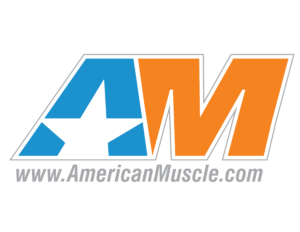 |  |  |


